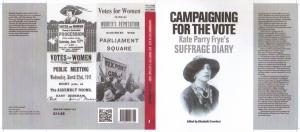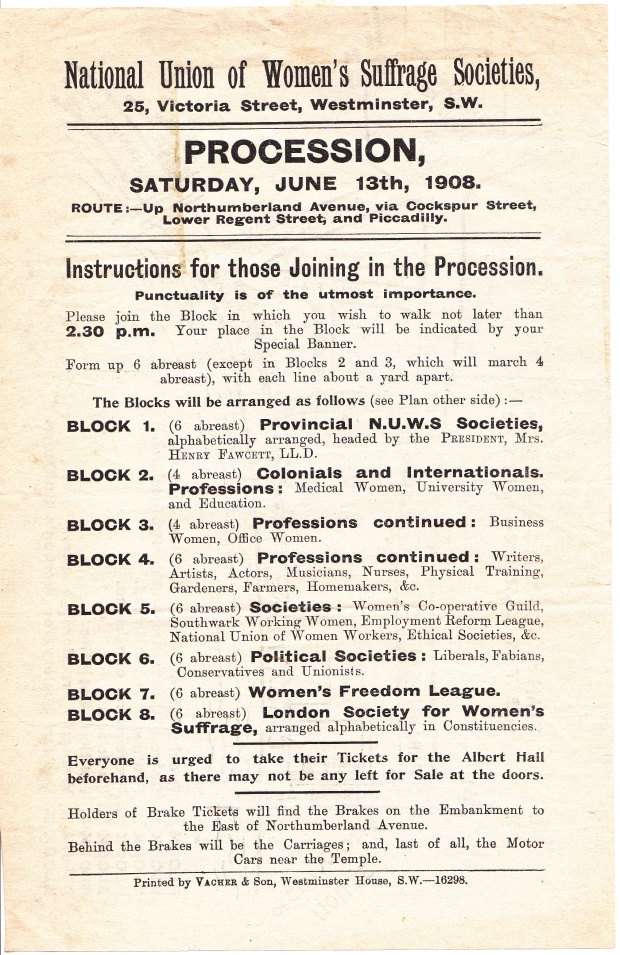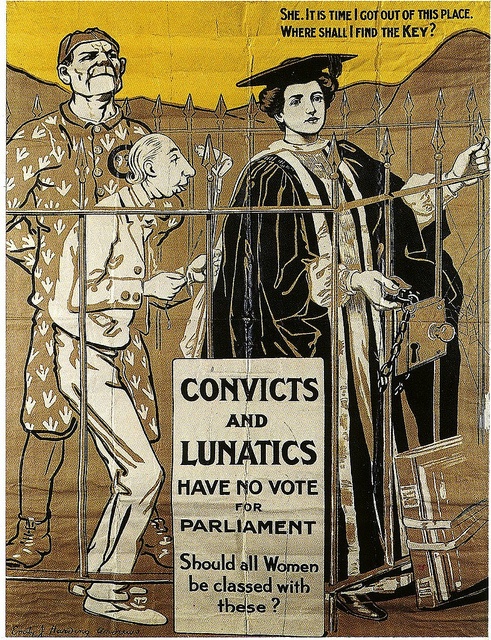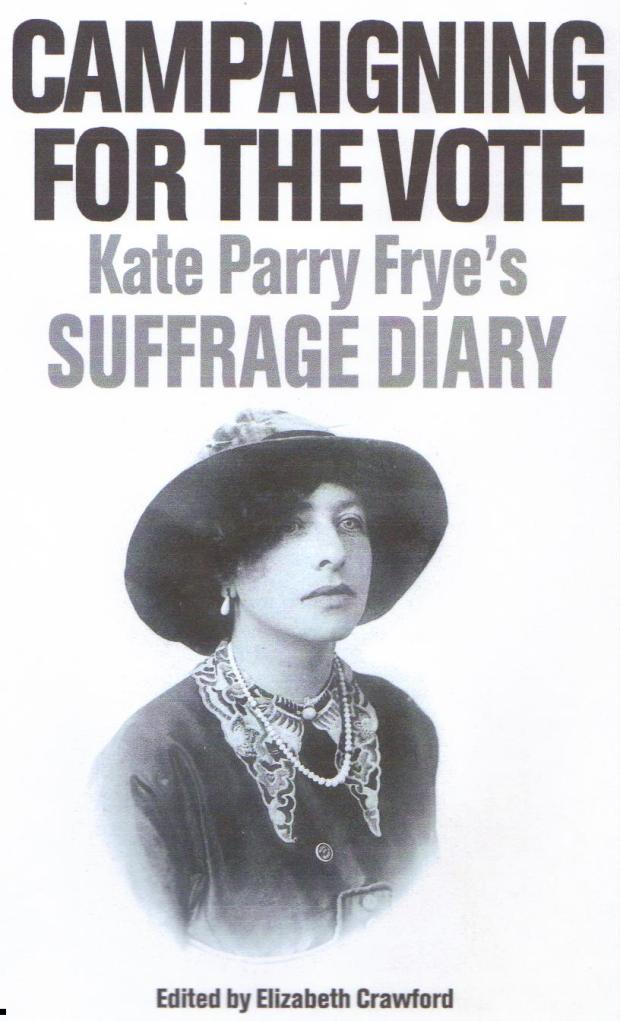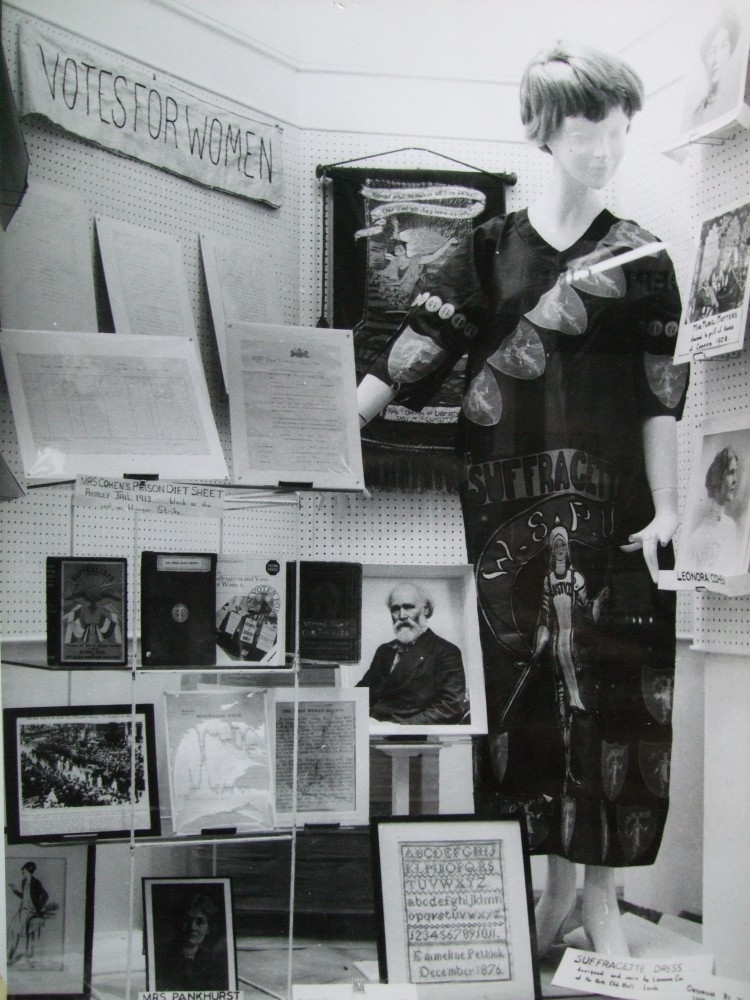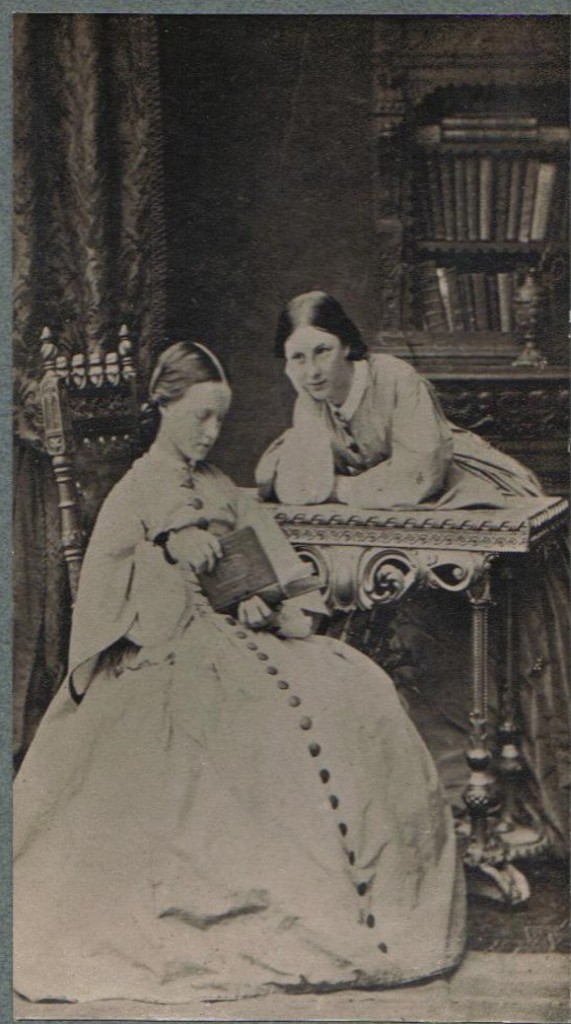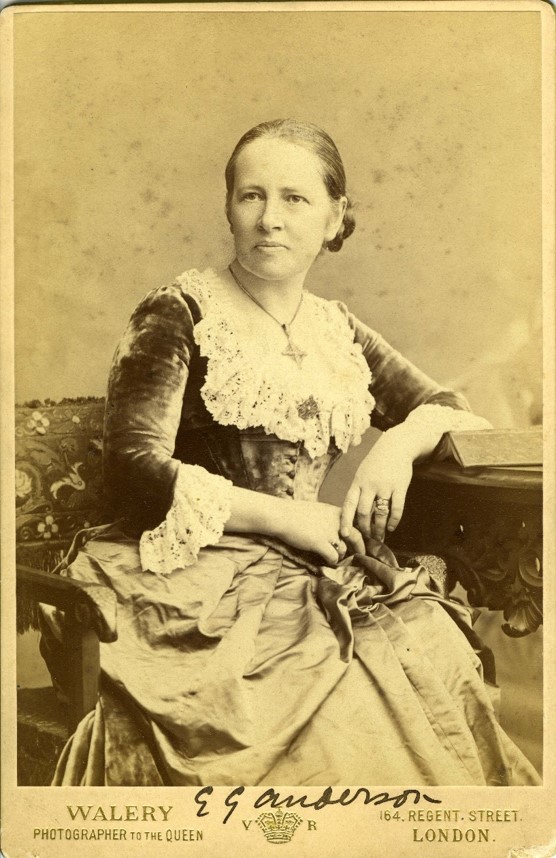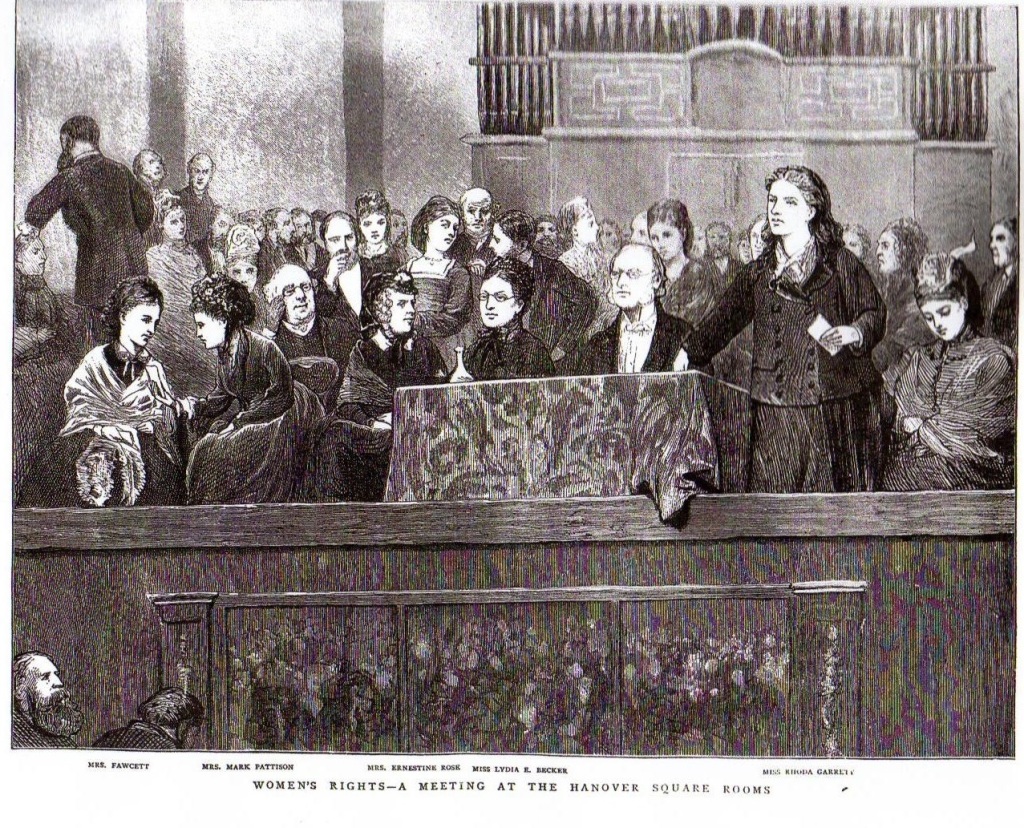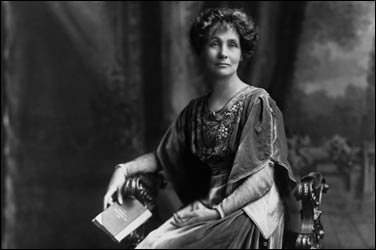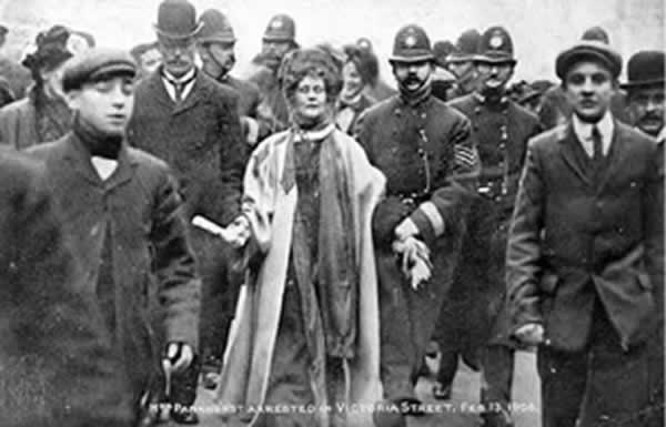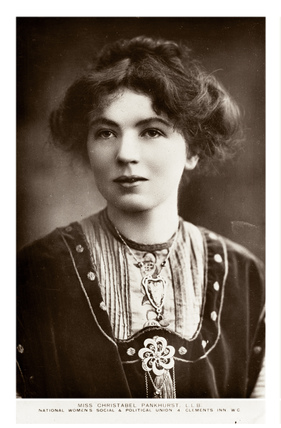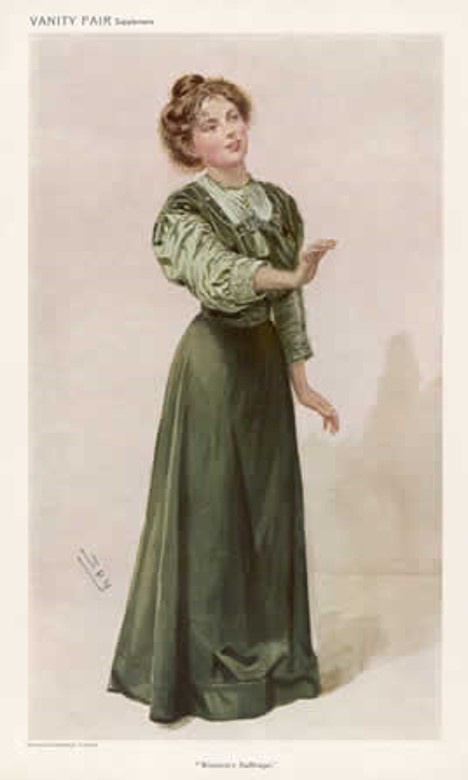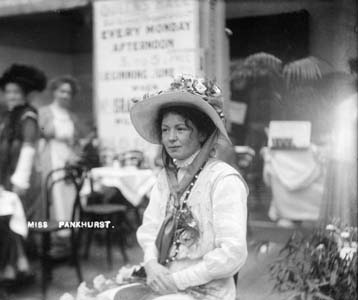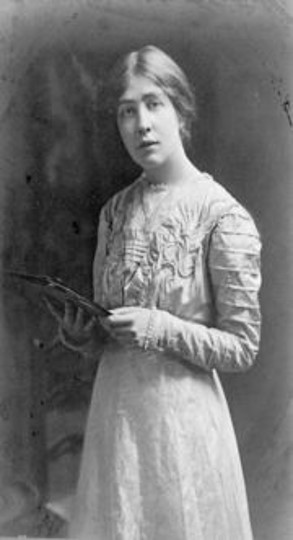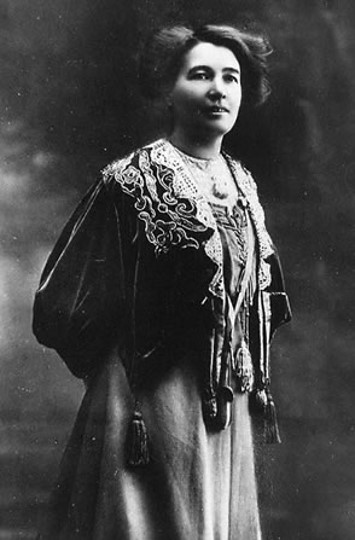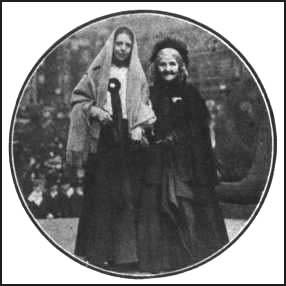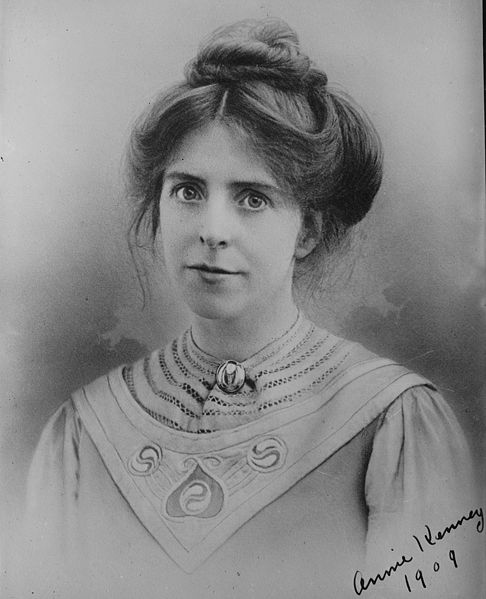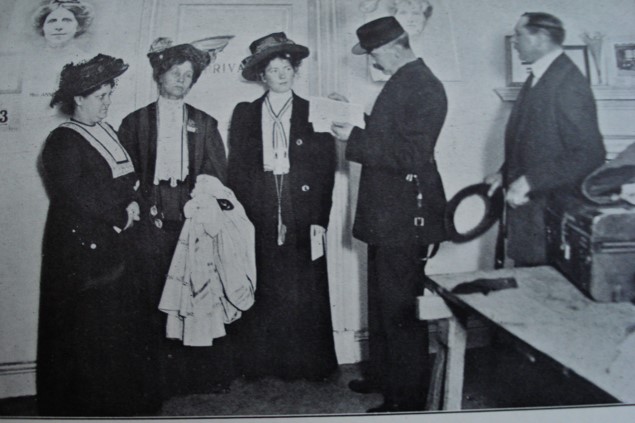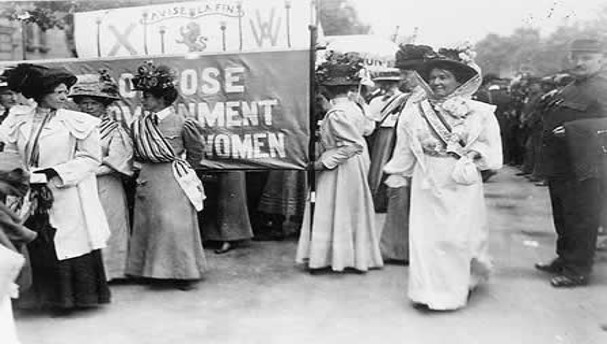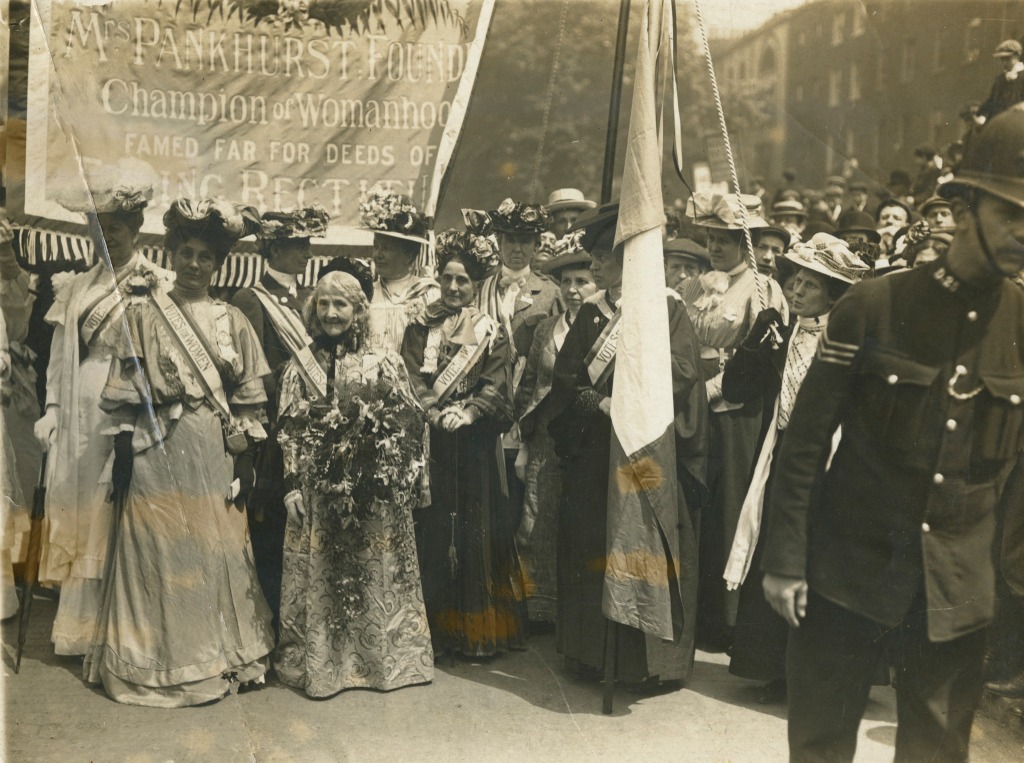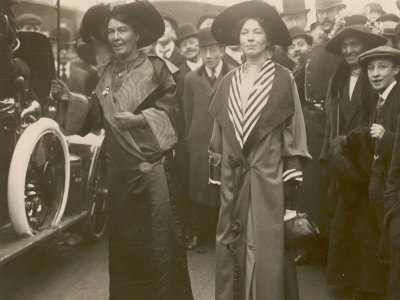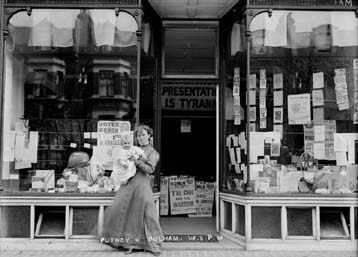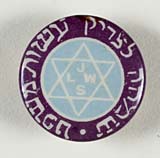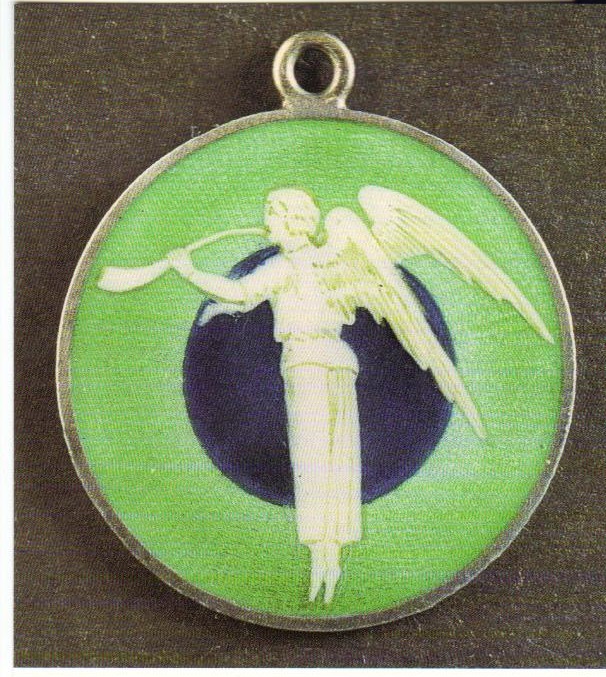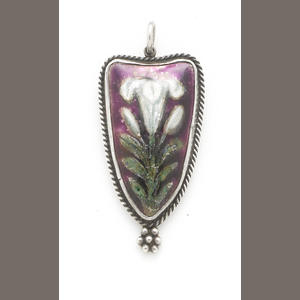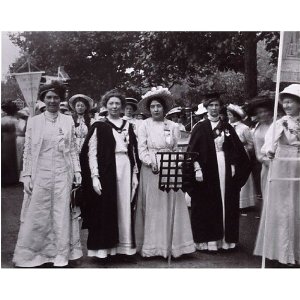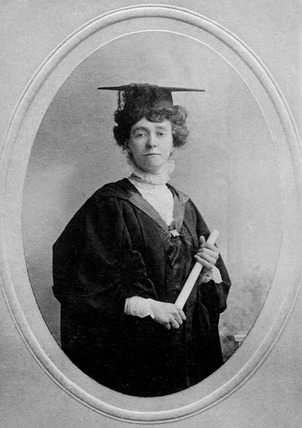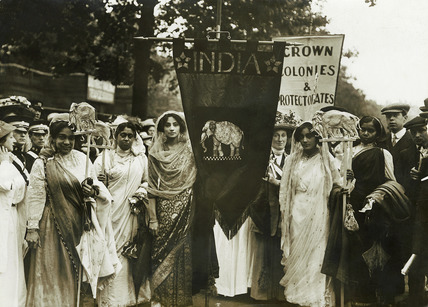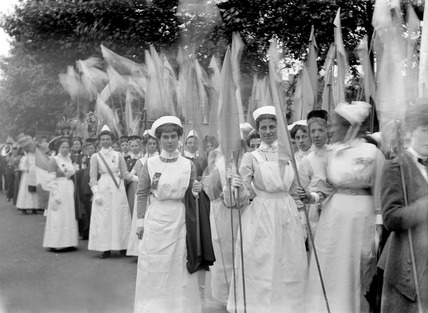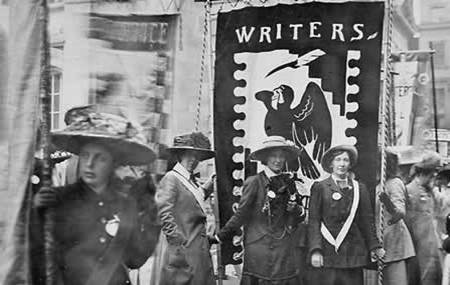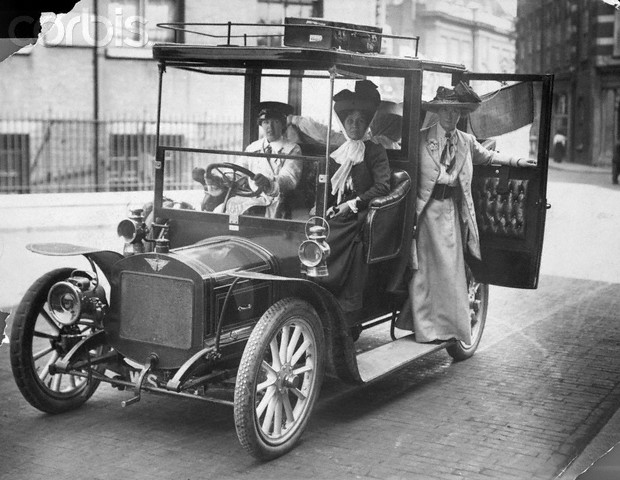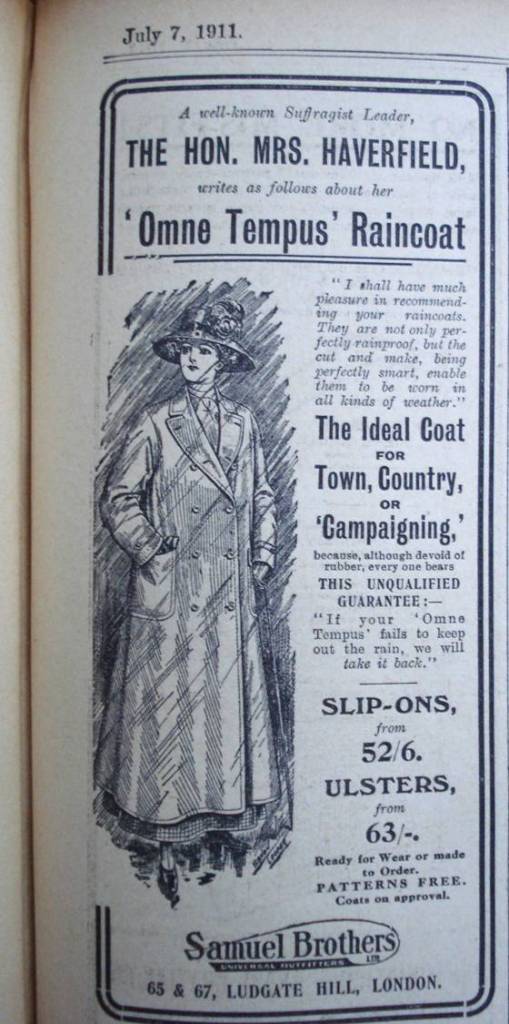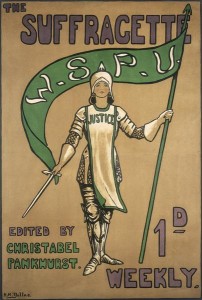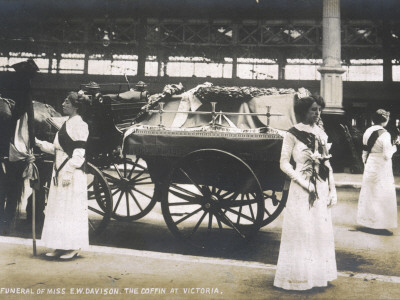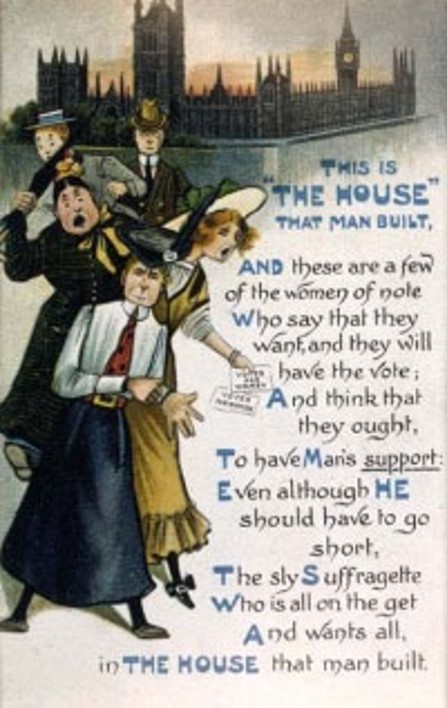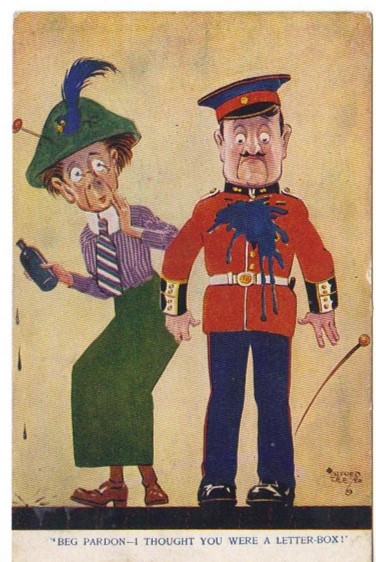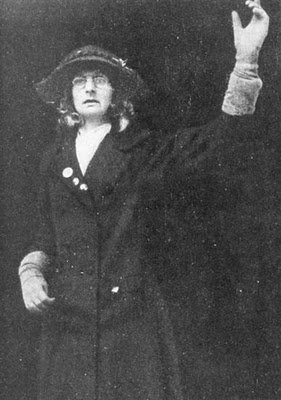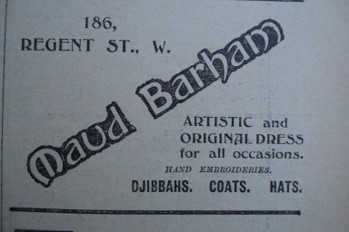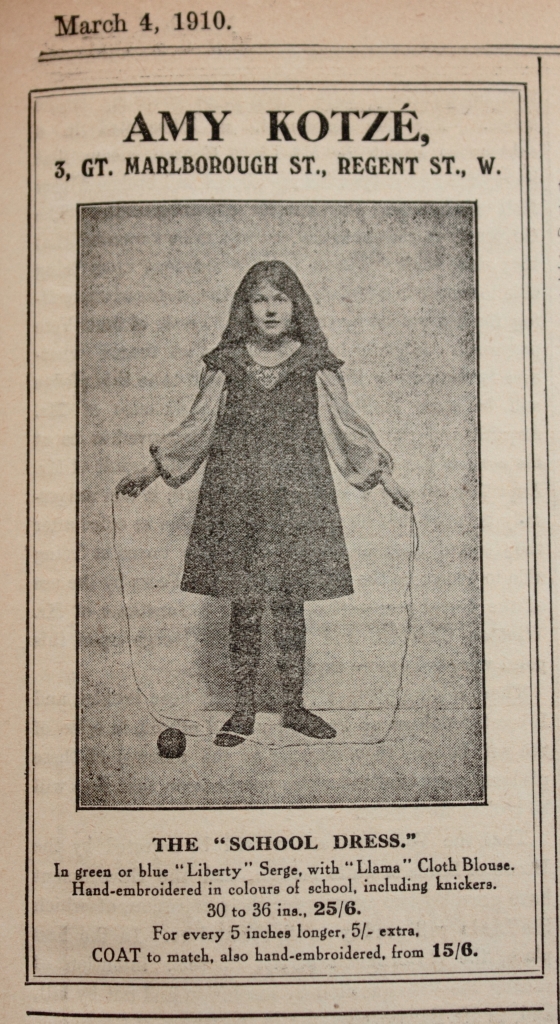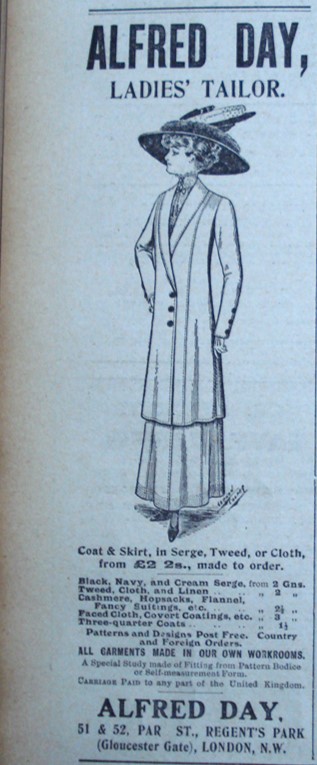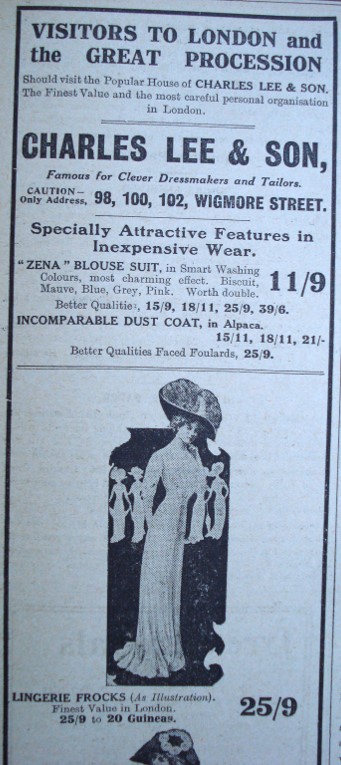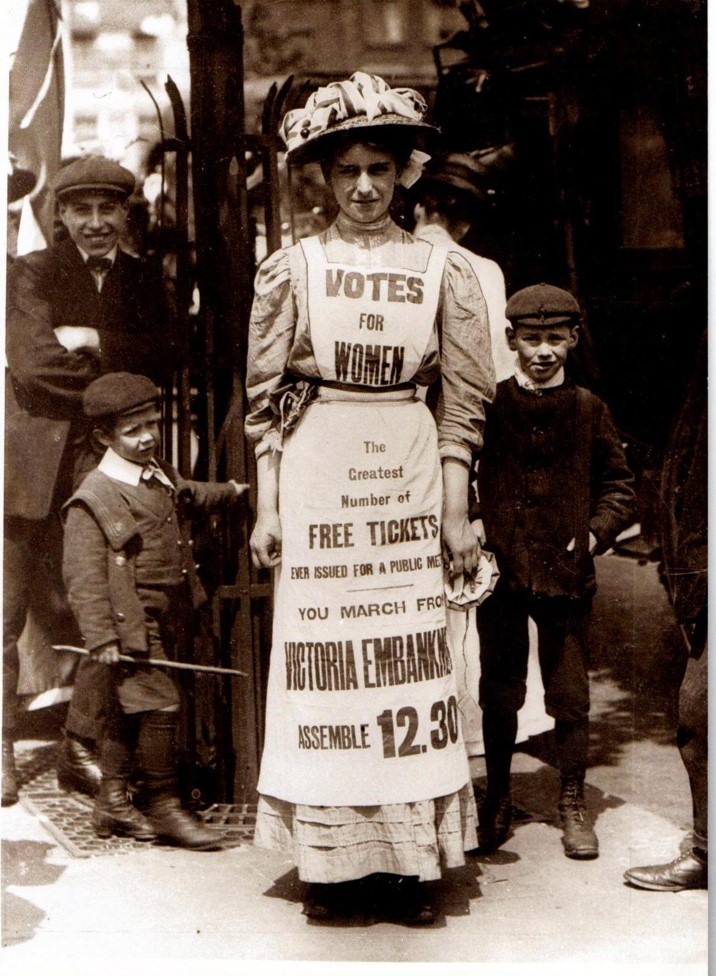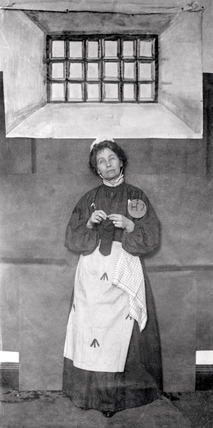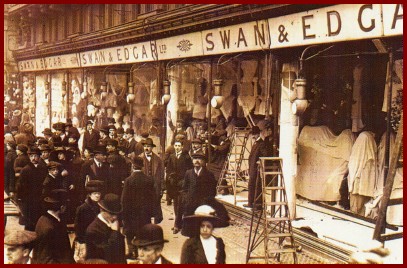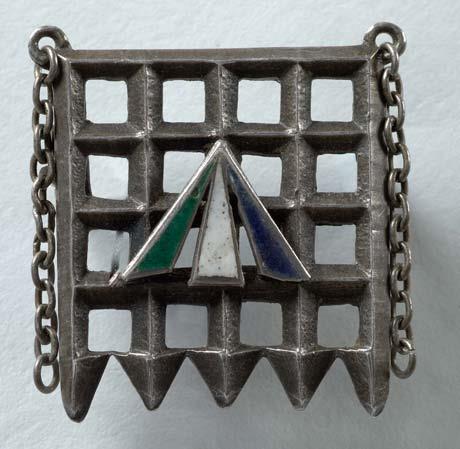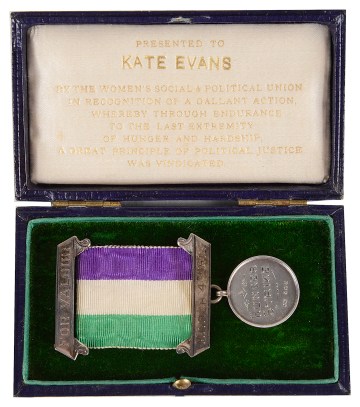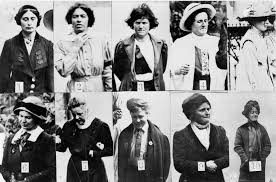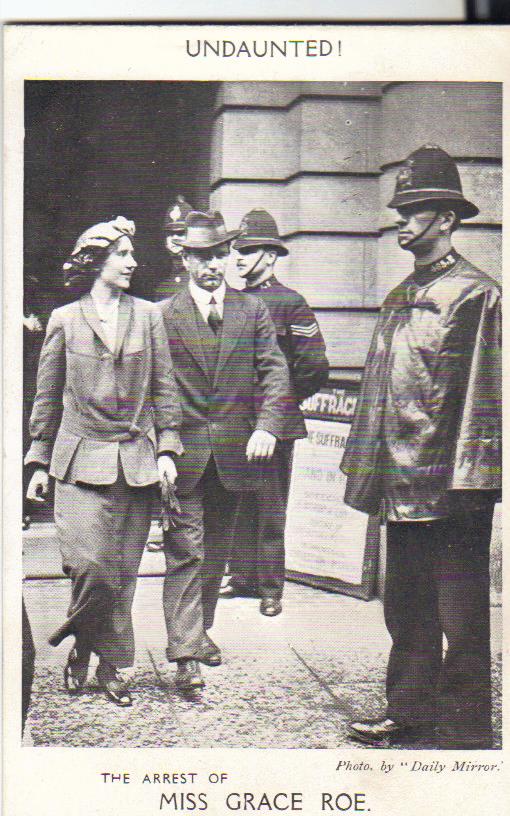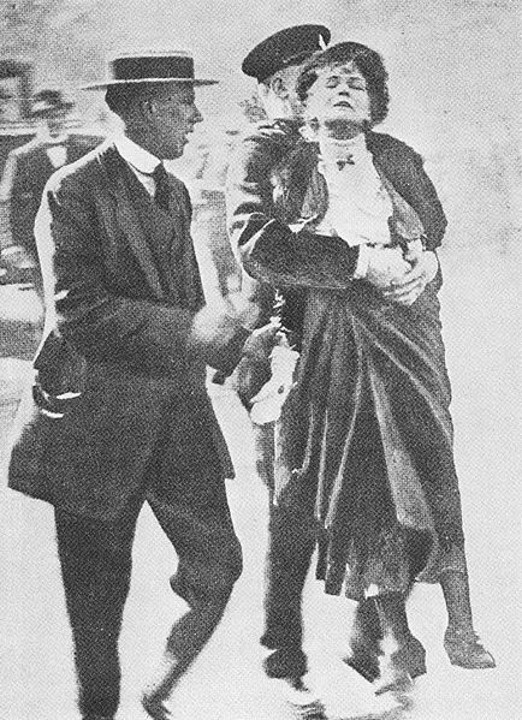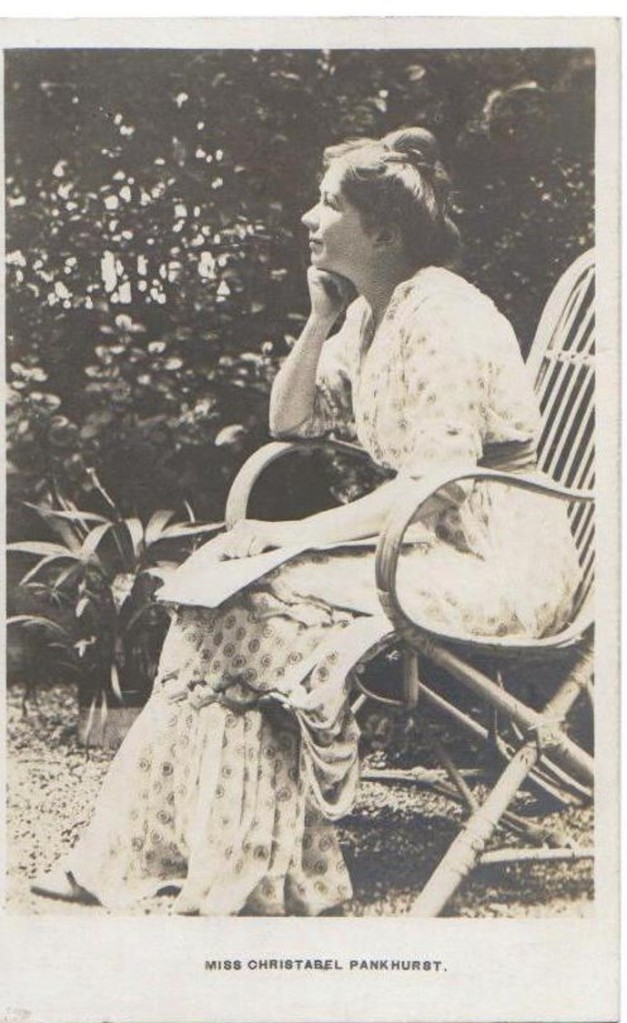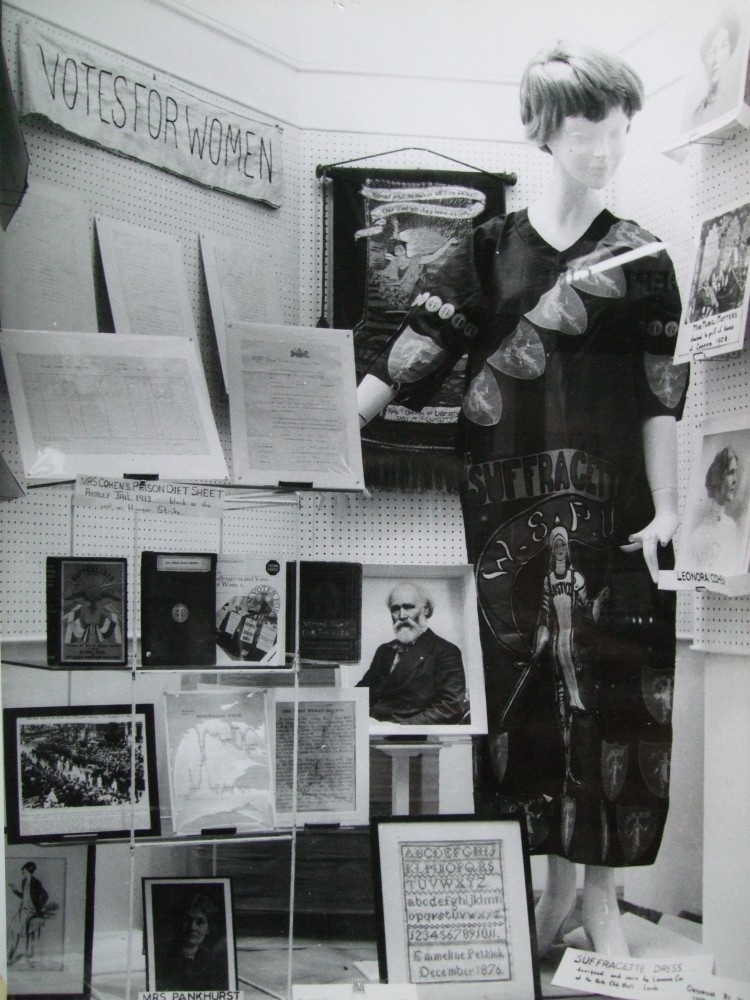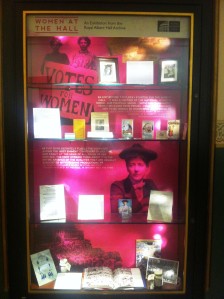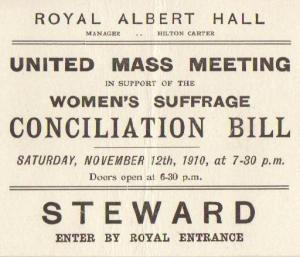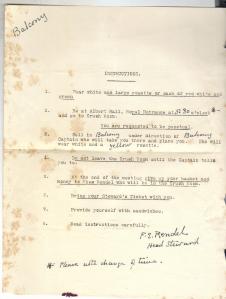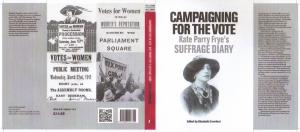Woman and her Sphere
List for Christmas 2013
Elizabeth Crawford
5 Owen’s Row
London EC1V 4NP
Send orders to me by email: e.crawford@sphere20.freeserve.co.uk
Payment may be made by cheque, Paypal or by direct bank transfer

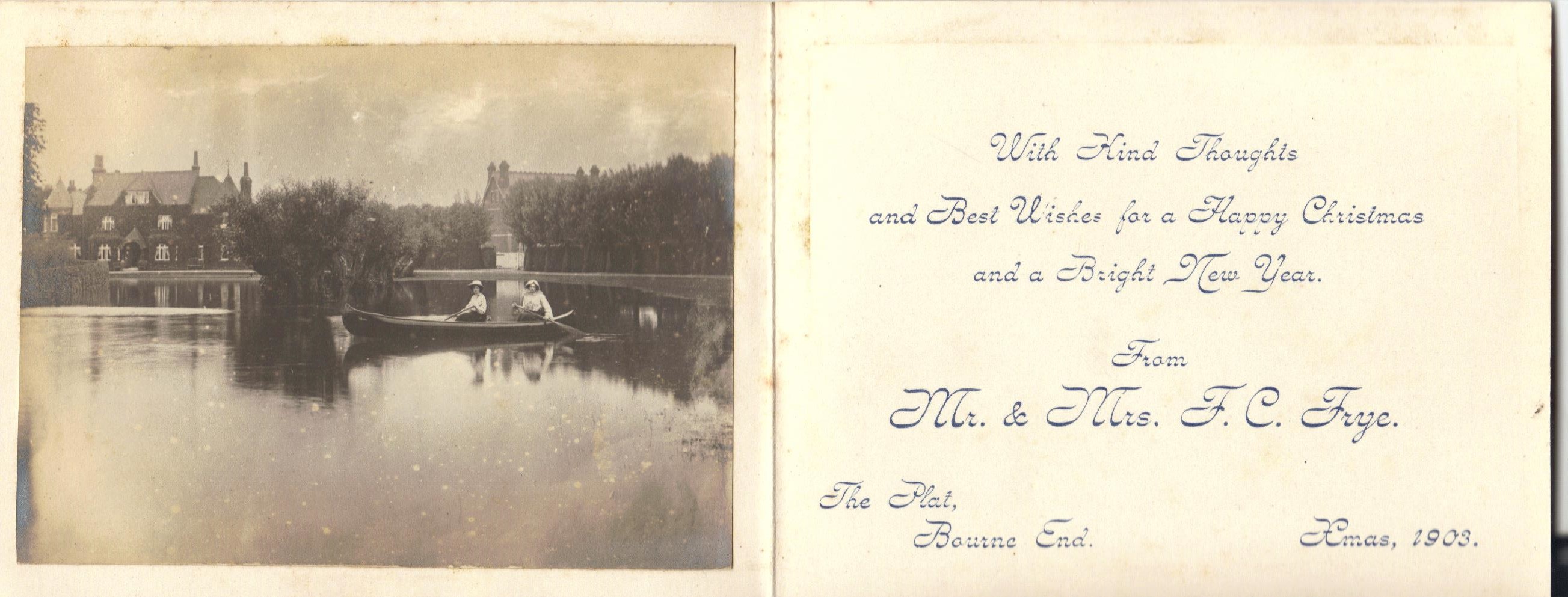
Item 178
During those ground-hog days between Christmas and the New Year why not lose yourself in the pre-First World War suffrage world.
I can send a signed copy of my latest book to you or, as a gift from you, to anyone you choose.

Campaigning for the Vote: The Suffrage Diary of Kate Parry Frye
Edited by Elizabeth Crawford
An extract
‘Saturday June 14th 1913. [Kate is lodging in Baker Street, London]
I had had a black coat and skirt sent there for Miss Davison’s funeral procession and the landlady had given me permission to change in her room. I tore into my black things then we tore off by tube to Piccadilly and had some lunch in Lyons. But the time was getting on – and the cortege was timed to start at 2 o’clock from Victoria. We saw it splendidly at the start until we were driven away from our position and then could not see for the crowds and then we walked right down Buckingham Palace Rd and joined in the procession at the end. It was really most wonderful – the really organised part – groups of women in black with white lilies – in white and in purple – and lots of clergymen and special sort of pall bearers each side of the coffin. She gave her life publicly to make known to the public the demand of Votes for Women – it was only fitting she should be honoured publicly by the comrades. It must have been most imposing. [Plus much more description of the procession as Kate follows it into King’s Cross station]
Campaigning for the Vote tells, in her own words, the efforts of a working suffragist to instil in the men and women of England the necessity of ‘votes for women’ in the years before the First World War. The detailed diary kept all her life by Kate Parry Frye (1878-1959) has been edited to cover 1911-1915, years she spent as a paid organiser for the New Constitutional Society for Women’s Suffrage. The book constitutes that near impossibility – completely new primary material, published for the first time 100 years after the events it records.
With Kate for company we experience the reality of the ‘votes for women’ campaign as, day after day, in London and in the provinces, she knocks on doors, arranges meetings, trembles on platforms, speaks from carts in market squares, village greens, and seaside piers, enduring indifference, incivility and even the threat of firecrackers under her skirt.
Kate’s words bring to life the world of the itinerant organiser – a world of train journeys, of complicated luggage conveyance, of hotels – and hotel flirtations – , of boarding houses, of landladies, and of the ‘quaintness’ of fellow boarders. This was not a way of life to which she was born, for her years as an organiser were played out against the catastrophic loss of family money and enforced departure from a much-loved home. Before 1911 Kate had had the luxury of giving her time as a volunteer to the suffrage cause; now she depended on it for her keep.
No other diary gives such an extensive account of the working life of a suffragist, one who had an eye for the grand tableau – such as following Emily Wilding Davison’s cortege through the London streets – as well as the minutiae of producing an advertisement for a village meeting. Moreover Kate Frye gives us the fullest account to date of the workings of the previously shadowy New Constitutional Society for Women’s Suffrage. She writes at length of her fellow workers, never refraining from discussing their egos and foibles. After the outbreak of war in August 1914 Kate continued to work for some time at the society’s headquarters, helping to organize its war effort, her diary entries allowing us to experience her reality of life in war-time London.
Excerpts from Campaigning for the Vote featured in ‘The Women’s Rebellion’, episode 2 of Michael Portillo’s Radio 4 series, 1913: The Year Before –listen here http://www.bbc.co.uk/programmes/b02mxyyz
ITV has selected Kate Frye – to be portrayed by a leading young actress – as one of the main characters in a 2014 documentary series to mark the centenary of the outbreak of the First World War.
And there are plans under discussion to make Kate’s story more widely known…..
Published by Francis Boutle Publishers – http://www.francisboutle.co.uk/product_info.php?products_id=102&osCsid=f25354bc872ffc120b251b6b63915492
Wrap-around paper covers, 226 pp, over 70 illustrations, all drawn from Kate Frye’s personal archive.ISBN 978 1903427 75 0
Signed copies available from me: £14.99 plus £3 postage to UK addresses.
Signed copies also available of:
Enterprising Women: the Garretts and their circle

Enterprising Women tells the story of a group of women around the Garrett family, who in the second half of the nineteenth century and the early years of the twentieth changed the position of women in Britain forever. Pioneering access to education at all levels for women both in academic and vocational subjects as well as training for the professions – medicine, architectural decoration, landscape design – they also involved themselves in politics and the campaign for women’s suffrage. As well as discussing in detail the work of Elizabeth Garrett Anderson, Millicent Garrett Fawcett and Emily Davies, this book brings to the foreground the careers of some less well known members of the group, including Rhoda and Agnes Garrett, the first women interior decorators, and Fanny Wilkinson, the first professional woman landscape gardener
‘Crawford’s scholarship is admirable and Enterprising Women offers increasingly compelling reading’ Journal of William Morris Studies
Francis Boutle, 2002 338pp 75 illus paperback
http://www.francisboutle.co.uk/product_info.php?cPath=17&products_id=7
Signed copies available from me: £14.99 plus £3 postage to UK addresses.
**
Woman and her Sphere List for Christmas 2013
NON-FICTION: WOMEN
1. BLAIR, Kirstie Form & Faith in Victorian Poetry & Religion OUP 2012 [13415] By assessing the discourses of church architecture and liturgy the author demonstrates that Victorian poets both reflected on and affected ecclesiastical practices – and then focuses on particular poems to show how High Anglican debates over formal worship were dealt with by Dissenting, Broad Church, and Roman Catholic poets and other writers. Features major poets such as the Browning, Tennyson, Hopkins, Rossetti and Hardy – as well as many minor writers. Mint in d/w (pub price £62) £35
2. BOUCHERETT, Jessie and BLACKBURN, Helen Conditions of Working Women and the Factory Acts Elliot Stock 1896 [13341] An extremely scarce and interesting study. Boucherett and Blackburn were particularly concerned that women should not be barred from trades by the dictat of Parliament – rather that their working conditions should be improved. The final chapter consists of ‘The Report to the Society for the Employment of Women on the work of women in the white lead trade, at Newcastle-on-Tyne, March, 1895. With illustrations. Good (back cover marked) – and very scarce (I have never – in nearly 30 years – previously had a copy in stock) £55
3. BROWN, Mike The Day Peace Broke Out: the VE experience, Sutton Publishing 2005 [8936] Describes VE-Day celebrations in Britain and across the world through the memories of those who were there. Illustrated with photographs, adverts, posters and cartoons. Soft covers – large format – mint £10
4. CLAPP, Elizabeth and JEFFREY, Julie Roy (eds) Women, Dissent and Anti-Slavery in Britain and America, 1790-1865 OUP 2011 [13422] Essays by David Turley, Timothy Whelan, Alison Twells, Clare Midgeley, Carol Lasser, Julie Roy Jeffrey, Stacey robertson and Judie Newman – with an Introduction by Elizabeth Clapp. Mint in d/w (pub price £60) £25
5. CLARK, Margaret Homecraft: a guide to the modern home and family Routledge, 3rd ed 1978 (r/p) [10288] The author was senior adviser for Home Economics for Derbyshire. The book was a textbook, suitable for school Home Economics courses. First published in 1966. Soft covers – very good £6
6. DAVID, Deirdre (ed) The Cambridge Companion to the Victorian Novel CUP 2012 (2nd ed) [13411] This second edition includes essays by Kate Flint, Caroline Levine, Nancy Armstrong, Lyn Pykett and Clare Pettit – amongst others. Soft covers – mint £15
7. GOOD HOUSEKEEPING’S HOME ENCYCLOPAEDIA Ebury Press 1968 (r/p) [10297] Packed with information and illustrations. How very retro. Large format – very good in rubbed d/w – heavy £10
8. GREGORY, James Victorians Against the Gallows: capital punishment and the abolitionist movement in 19th-century Britain I.B. Tauris 2011 [13421] The first comprehensive study on the movement against Capital Punishment in Victorian Britain. Mint in d/w (pub price £65) £35
9. HILEY, Michael Victorian Working Women: portraits from life, Gordon Fraser 1979 [13340] Photographs of working women most of them collected during the second half of the 19th century by A.J. Munby. Paper covers – very good £12
10. LARSEN, Timothy A People of One Book: the Bible and the Victorians OUP 2011 [13407] Case studies of representative figures, from Elizabeth Fry to Florence Nightingale, from C.H. Spurgeon to Grace Aguilar to demonstrate the scripture-saturated culture of 19th-century England. Mint in d/w (pub price £76) £25
11. LEE, Julia Sun-Joo The American Slave Narrative and the Victorian Novel OUP 2010 [13436] Investigates the shaping influence of the American slave narrative on the Victorian novel in the years between the British Abolition Act and the American Emancipation Proclamation – and argues that Charlotte Bronte, Elizabeth Gaskell, Thackeray and Dickens integrated into their works generic elements of the slave narrative. Mint in d/w (pub price £40) £15
12. LOANE, M. An Englishman’s Castle Edward Arnold 1909 [9060] Martha Loane was a district nurse – this study of the homes of the poor is the result of her social investigation. Good £18
13. LOFTIE, W.J. A Plea for Art in the House: with special reference to the economy of collecting works of art, and the importance of taste in education and morals Macmillan 1879 (r/p) [13338] First published in 1876 – around the same time as Rhoda and Agnes Garrett’s book in the same series ‘Art at Home’ – and evincing many of the same touchstone’s of taste in home decoration. Goodish – a little rubbed and bumped £18
14. ORRINSMITH, Mrs The Drawing Room: its decoration and furniture Macmillan 1877 [9344] In the ‘Art at Home’ series. ‘The author has endeavoured to give more particular directions as to the furnishing and adornment of the Drawing-Room than was possible in the Miss Garretts’ volume treating of the whole subject of ‘House Decoration’ .’ Very good – missing free front end paper many illustrations – a scarce book £45
15. PALMER, Beth Women’s Authorship and Editorship in Victorian Culture OUP 2011 [13432] Draws on extensive periodical and archival material to bring new perspectives to the study of sensation fiction in the Victorian period. Mint in d/w (pub price £60) £35
16. RAPPOPORT, Jill Giving Women: alliance and exchange in Victorian culture OUP 2012 [13413] examines the literary expression and cultural consequences of English women’s giving from the 1820s to the First World War – in the work of Charlotte Bronte, Elizabeth Barrett Browning, Elizabeth Gaskell and Christina Rossetti – as well as in literary annuals and political pamphlets. Through giving, women redefined the primary allegiances of teh everyday lives, forged public coalitions, and advanced campaigns for abolition, slum reform, eugenics, and suffrage. Mint in d/w (pub price £45.99) £32
17. RODENSKY, Lisa (ed) The Oxford Handbook of the Victorian Novel OUP 2013 [13431] A cornucopia! Mint in d/w – heavy – 808pp. (pub price £95) £50
18. SLATER, Michael The Great Dickens Scandal Yale University Press 2012 [13420] How Dickens sought to cover up his relationship with Ellen Ternan. Mint in d/w (pub price £20) £8
19. STONE, S. A. Home-Making: practical household hints C. Arthur Pearson 1915 [13570] One quails at the amount of routine work that was expected of the housewife and clearly, even when dirt was so much more of a threat and smoke pollution so much more damaging, it can’t really have been necessary to do all that the writers of such guides stipulated. I’m exhausted just reading it. Good reading copy £8
20. STOREY, Joan Home Service Book: the answers to your everyday problems in the home Hodder & Stoughton 1955 [10275] With numerous photographs of, for instance, heating equipment – v. evocative. Good £6
21. TINDALL, Gillian Three Houses, Many Lives: the story of a Cotswold vicarage, a Surrey boarding school and a London home Vintage 2013 [13417] Once again Gillian Tindall works her magic. I loved it (I bought my own copy!) £5
22. VANCE, Norman Bible & Novel: narrative authority and the death of God OUP 2013 [13412] ‘In our increasingly secular society novel-reading is now more popular than Bible-reading. Serious novels are often taken more seriously than scripture. The author looks at how this may have come about as an introduction to four best-selling late-Victorian novelists: George Eliot, Thomas Hardy, Mary War, and Rider Haggard.’ Mint in d/w (pub price £55) £28
23. VINCE, Mrs Millicent Decoration and Care of the Home W. Collins 1923 [12870] Mrs Vince had been a pupil of the pioneer ‘House Decorator’, Agnes Garrett. Very good in rubbed d/w £18
BIOGRAPHY
24. (ADDAMS) Louise Knight Jane Addams: Spirit in Action Norton 2011 [13405] Biography of the US campaigner for international peace and social justice. Mint in d/w £10
25. (BRONTE) Margaret Smith (ed) Selected Letters of Charlotte Bronte OUP 2010 [13426] With a new introduction by Janet Gezari. Soft covers – mint £3
26. [GARDINER] Sarah Gardiner (ed) Leaves from a Young Girl’s Diary: the journal of Margaret Gardiner 1840-41 Tuttle, Moorhouse & Taylor Co (NY) 1927 [13478] The journal kept by Margaret Gardiner who, with her father, a NY State Senator, her mother and her sister (who was to become the wife of a US President), sailed across the Atlantic to Europe. They landed at Liverpool and then proceeded to ‘do’ Europe. Delightful. Very good – scarce £45
27. (LIDDELL) Simon Winchester The Alice Behind Wonderland OUP 2011 [13406] ‘Using Charles Dodgson’s published writings, private diaries, and of course his photographic portraits, Winchester gently exposes the development of Lewis Carroll and the making of his Alice.’ Mint in d/w £6
28. (ROBINS) Octavia Wilberforce Backsettown & Elizabeth Robins published for private circulation 1952 [13258] A little tribute – telling how Elizabeth Robins came to set up the retreat at Backsettown in Sussex. With lovely photograph of Elizabeth Robins tipped in as frontispiece. Fine in paper wraps – with a birthday inscription on free front endpaper – scarce £38
29. (SIMPSON) Morrice McCrae Simpson: the turbulent life of a medical pioneer Birlinn 2011 [13433] The discoverer of ‘the blessed chloroform’ and, as such, an important figure in ‘woman’s sphere’. Soft covers – mint £5
30. (STOREY) STOREY, Joyce Joyce’s War 1939-1945 Virago 1992 (r/p) [13482] Soft covers -very good £4
31. (STUART) Hon. James A. Home (ed) Letters of Lady Louisa Stuart to Miss Louisa Clinton David Douglas (Edinburgh) 1901 & 1903 [13335] Two volumes – complete set. The first volume covers the period 1817 to 1825 and the second volume (called ‘Second Series’) that from1826 to 1834. Society observed. Very good – two volumes together £38
32. (THACKERAY) John Aplin Memory and Legacy: A Thackeray Family Biography 1876-1919 Lutterworth Press 2011 [13409] Draws extensively on private collection of descendants of the 19th-century Thackerays and focuses principally on the later years of Anne Thackeray Ritchie, whose amazingly intricate network of family and friendships offers fresh insights into the artistic milieu of the late-Victorian and Edwardian eras. Soft covers – very good £15
EPHEMERA
33. The Home Friend (New Series) SPCK 1854 [8313] 4 vols of miscellany of fact and fiction. Very good in embossed decorative original cloth – together £45
34. HOSMER, Harriet [13465] 2pp handwritten letter, on black-edged note paper, written by the American sculptor, Harriet Hosmer (1830-1908), from her studio in Rome – at ’38 Gregoriana’. She is inviting ‘Mrs Newton’ to her studio and giving details of the times of her ‘open house’. Mrs Newton, with her husband, is in Rome on a visit. There is no date – but probably 1860s or 1870s? Fine £20
35. LONDON (ROYAL FREE HOSPITAL) SCHOOL OF MEDICINE FOR WOMEN (UNIVERSITY OF LONDON) [13520] An appeal to build an extension – c 1915. Consists of a brief history of the School and photographs -interior and exterior – of the building and its begetters. Fine £25
36. THE HOME ARTS & INDUSTRIES ASSOCIATION A Collection of the Association’s Reports [13332] The Home Arts & Industries Association was founded in 1884 by Eglantyne Jebb and was instrumental in spearheading a revived interest in the craft movement. The Association had its office and studios in the Royal Albert Hall. The collection comprises the Reports for 1902, 1905, 1906 (1 two-sided leaflet and a 4-pp leaflet setting out barest details of the Association, which appears to have been undergoing a financial crisis. I am not sure whether there were reports for 1907 and 1908), 1909, 1910, 1911, 1912, 1913, 1914, 1915, 1916, 1917, 1918. Most in very good condition (that for 1902 may be disbound, front page is present, but loose). – ex-Board of Education Library. Together £55
37. BEDFORD COLLEGE The Common Room [13254] Real photographic card – I can see a print of G. F.Watts’ ‘Hope’ among the pictures – and is that a portrait of Emily Penrose over the fireplace? I’m not sure. Very good – printed in Berlin so probably dates from pre-1914 – unposted £10
38. GEORGE LANSBURY, MP, LCC [13279] real photographic postcard published by the Church Socialist League, London branch, pre – First World War. Fine – unposted £25
39. KITTY GILLOW [10700] poses in top hat and tails – with cigar. A latter-day music-hall actress, she has signed her photograph – which was taken in Jersey in 1964 £5
40. MISS ELLA SHIELDS B. Feldman 1914 [10675] sings ‘Just One Kiss – Just Another One’ and is photographed in top hat and tails on the cover of the sheet music. The song was written by William Hargreaves and Dan Lipton. Very god £7
41. MISS ELLA SHIELDS Campbell, Connelly & Co 1925 [10678] sings ‘Show Me the Way to Go Home’, written by Irving King, and is photographed as an awkward young man on the cover of the sheet music. Good £6
42. MISS ELLA SHIELDS Lawrence Wright 1925 [10681] sings ‘When the Bloom is On the Heather’ and is photographed in top hat and tails on the cover of the sheet music. Very good £6
43. MISS ELLA SHIELDS Francis, Day & Hunter 1927 [10682] sings ‘I’m Looking Over a Four Leaf Clover’ and is photographed in close up on the cover wearing her top hat and white bow tie. Fair – some marks on cover £5
44. MISS ELLA SHIELDS Lawrence Wright 1929 [10688] sings ‘Home in Maine’ and is photographed in sailor attire on cover of sheet music. Good £6
45. MISS HETTY KING Francis, Day & Hunter 1908 [10684] sings ‘I’m Afraid to Come Home in the Dark’ and is photographed on the cover of the sheet music in extravagantly elegant top hat and tails. Very good £7
46. MISS NORA DELANEY Lawrence Wright 1929 [10687] sings ‘Glad Rag Doll’ and is photographed in male evening dress on the cover of the sheet music. Good £5
47. MISS VESTA TILLEY [10695] photographic postcard of her in waistcoat and trilby, together with a cigarette card of woman in male evening dress. Good – card posted in 1907 £6
48. MISS ZENA DARE [10693] photographic postcard of her in male attire. Very good – posted in 1906 £5
49. ‘MR WINIFRED WARD’ [10697] as she signs in ink (real signature) a photograph of herself in evening dress. She was an acclaimed male impersonater in the early 20th century. Fine £7
50. VESTA TILLEY Francis, Day & Hunter 1905 [10670] sings ‘Who Said, “Girls”?’. Sheet music featuring photograph on cover of Vesta Tilley in smart male attire. The ditty begins: ‘One day on a Western claim/Miners vow’d their lives were tame, For in that lonel spot there seldom girls had been.’ Good £7
51. VESTA TILLEY Francis, Day & Hunter 1896 [10672] sings ‘He’s Going In For this Dancing Now’, sheet music, written by E.W. Rogers. Very good – except that the front cover is semi-detached £5
52. VESTA TILLEY Francis, Day & Hunter 1894 [10683] sings ‘By the Sad Sea Waves’ and is photographed in colour on the cover of the sheet music. Good – though spine strengthened £7
FICTION
53. BRONTES, The Tales of Glass Town, Angria, and Gondal: selected writings OUP 2010 [13427] Edited with Introduction and Notes by Christine Alexander. Soft covers – mint £6
54. GASKELL, Elizabeth Cranford OUP 2011 [13428] With introduction by Dinah Birch. Soft covers – mint £4
55. NELSON, Cary (ed) The Oxford Handbook of Modern and Contemporary American Poetry OUP 2012 [13429] Mint in d/w – heavy – 716pp (pub price £95) £50
56. VYNNE, Nora The Pieces of Silver Andrew Melrose 1911 [13337] One of the dedicatees of this novel is Franklin Thomasson, whose family had a long association with the women’s suffrage movement. The heroine is a feminist journalist and political campaigner – as was the author, who co-authored, with Helen Blackburn, ‘Women Under the Factory Acts 1903’ (see item # ). While not being categorically ‘suffrage’, it is so very close to that genre that I have included it in this section. A scarce book £48
WOMEN’S SUFFRAGE
57. DOBBIE, B.M. Willmott Dobbie A Nest of Suffragettes in Somerset: Eagle House, Batheaston Batheaston Society 1979 [13585] The story of the Blathwayt family and their involvement in the women’s suffrage movement – copiously illustrated by the photographs taken by Col Blathwayt. Soft covers – quite scarce £26
58. KING, Elspeth The Scottish Women’s Suffrage Movement People’s Palace, Glasgow 1978 [13272] Soft-covered booklet that was published to accompany the ‘Right to Vote’ exhibition organised by the People’s Palace Museum to commemorate the 50th anniversary of the 1928 Representation of the People Act. Very good £12
59. (PANKHURST) Emmeline Pankhurst My Own Story Eveleigh Nash 1914 [13265] Mrs Pankhurst’s authobiography, written with the help of the American journalist, Rheda Childe Dorr. Good – scarce £55
60. HINE, Muriel The Man With the Double Heart John Lane 1914 [13336] A ‘suffrage’ novel. The heroine’s mother is a Militant Suffragette; she is not. Good £18
WOMEN’S SUFFRAGE: EPHEMERA
61. A Brief Review of the Women’s Suffrage Movement since its Beginning in 1832 [NUWSS], printed by Vacher & Sons April 1911 [13505] 16-pp pamphlet. Very good – would be fine but it has lost its staples. With the ownership inscription of a ‘Mrs Kerr’ on the cover. £35
62. ADA HINES [12587] (1872-1949) of ‘The Nook’, Ashton-on-Mersey, was an artist and a suffragette – the joint founder, in 1909, with her friend and fellow artist, Lucy Fildes, of the Manchester branch of the Women’s Freedom League. Here is an opportunity to acquire a small oil painting by her – unframed – on board – entitled ‘Sunset’. Signed but undated – rather atmospheric. £75
63. BODICHON, Mrs Reasons for the Enfranchisement of Women London National Society for Women’s Suffrage, no date late 1860s? [9519] Printed by Head, Hole & Co, Farringdon Street and Ivy Lane, E.C. Scarce and important pamphlet -8pp – good £250
64. CORONATION PROCESSION 17 June 1911 [11274] A stereoscope photograph of ‘The Empire Car’ – part of the ‘Pageant of Empire’ part of the procession staged by the suffrage societies to mark the Coronation of George V. Very good £95
65. ELMY, Elizabeth Wostenholme Woman’s Franchise: the need of the hour ILP 2nd ed, no date [1907] [12760] A campaigner for women’s suffrage since the mid-1860s, she had put aside a lifetime’s aversion to party politics and joined the Manchester ILP in 1904. This article was originally published in the ‘Westminster Review’. In her concise style she analyses the events of the previous 40 years and demands that Liberal MPs who profess to support women’s suffrage honour their pledges. £65
66. HILL, MISS OCTAVIA Women and the Suffrage 1910 [13150] 2-sided leaflet, reproducing a letter from Octavia Hill to the Editor of the ‘Times’, dated 14 July 1910. In this she repudiates the necessity of votes for women – ‘Let the woman seek the quiet paths of helpful real work, be set on finding where she is wanted, on her duties, not on her rights…’ The 2-sided leaflet was printed by the National Press Agency Ltd and does not carry the imprimatur of the anti-suffrage society, although I imagine that group was probably behind its publication, the NPA being their usual printer. Good – very scarce £68
67. IN MEMORIAM Rt Hon Lord and Lady (Emmeline) Pethick-Lawrence of Peaslake [13195] 4-pp leaflet describing the various commemorations of the lives of the Pethick-Lawrences. Issued by the Suffragette Fellowship under the names of Lady (Helen) Pethick-Lawrence and Grace Roe. Good £15
68. LEIGH SMITH, Barbara A Brief Summary in Plain Language of the Most Important Laws Concerning Women; together with a few observations thereon Holyoake & Co, 2nd edition revised with addition 1856 [9033] Barbara Leigh Smith (later Barbara Bodichon) was 27 years old when she wrote this pamphlet, first published in 1854 as part of her campaign to change the Married Women’s Property Acts. This pamphlet is extremely scarce (I have never had a copy for sale before), bound inside recent paper covers. Rather amusingly, the printed price of ‘Threepence’ has been scored through and ‘1 1/2 d’ added – a comment, presumably, then on the interest being shown in the campaign by a public not yet awakened to the cause. Very good £280
69. LYDIA BECKER [12607] Letter from Lydia Becker to ‘Mr Levi’ – written from 85 Carter St, Greenyes, Manchester on ‘Oct 16’ – I have worked out that the year is1868. ‘Mr Levi’ is probably Prof Leone Levi, to whom she had sent a pamphlet a few days earlier. I think, in response, he had written to her in admiration asking for some material from her for his autograph book. In this letter, in return, she writes ‘I have written out my three Norwich prospositions ,[these are drawn from her address at Norwich to the British Association Section F on 25 Aug 1868] which I hope may serve your purpose as a curiosity! for your autograph book, and a bone of contention for your friends.’ These ‘three Norwich propositions’ are set out on a separate sheet. But, in addition, in her 4-pp mss letter she sets out ‘my general wishes and conclusions as to the rights of women’.. All the material has been carefully attached to a sheet that once was page 77 in a collection of autograph material. Incidentally the material on the reverse, p 78, is in Italian, lending credence to my supposition that the correspondent was Leone Levi, who had left his native Italy for Liverpool in 1844. A very interesting letter – very good £95
70. MEN’S LEAGUE FOR OPPOSING WOMAN SUFFRAGE Gladstone on Woman Suffrage MLOWS c. 1909 [13146] The Men’s League for Opposing Woman Suffrage was founded in early 1909 and in 1910 merged with the Women’s National Anti-Suffrage League to form the National League for Opposing Woman Suffrage. This pamphlet – reproducing the Grand Old Man’s words on the subject is pamphlet no 3 issued by the Men’s League, presumably quite soon after its founding in 1909. 4-pp – good, with some foxing, scarce £78
71. MEN’S LEAGUE FOR OPPOSING WOMAN SUFFRAGE Is Woman Suffrage A Logical Outcome of Democracy? MLOWS c 1909 [13147] Pamphlet no 6 published by the short-lived Men’s League for Opposing Woman Suffrage. 4-pp – very good – scarce £60
72. MISS MORGAN, OF BRECON The Duties of Citizenship Women’s Local Government Society c 1912 [12946] Extracts reprinted from a paper read at the Annual Conference of the National Union of Women Workers, Manchester, October 27th 1896. By the time this leafet was issued Miss Morgan had been Mayor of Brecon, 1911-12. 4-pp – good – withdrawn from the Women’s Library £15
73. NATIONAL LEAGUE FOR OPPOSING WOMAN SUFFRAGE Mr J.R. Tolmie’s Reply to Mr L. Housman’s Pamphlet NLOWS no date (1913) [13145] The pamphlet of Laurence Housman’s to which this refers is ‘The Physical Force Fallacy’. Pamphlet no 37 issued by the National League for Opposing Woman Suffrage. 4-pp – very good £65
74. NATIONAL LEAGUE FOR OPPOSING WOMAN SUFFRAGE Woman Suffrage and the Factory Acts NLOWS no date [13155] A 4-pp leaflet, no 8 in the NLOWS series, pointing out that the ‘Women’s Party’ (ie pro-suffrage campaigners) were opposed to the ‘humane acts’ limiting women’s work in factory etc because ‘most of them harbour such a jealous mistrust of men that they suppose even their evidently disinterested actions to be prompted by insidious and harmful motive.’ The leaflet concludes ‘To grant women the franchise would therefore be to raise a fresh obstacle in the way of progress and to defer reforms still necessary for the welfare of the working classes..’ Very good – very scarce £75
75. NATIONAL SOCIETY FOR WOMEN’S SUFFRAGE CENTRAL COMMITTEE: First Report of the Executive Committee presented at the General Meeting of the Central Committee held on Wednesday 17 July 1872 National Society for Women’s Suffrage 1872 [12931] See my ‘Women’s Suffrage Movement: a reference guide’ as to how and why the Central Committee came into being. This – the Committee’s first report, contains lists of names of members of the Committee, of subscribers, and of the Local Committtes around England and Scotland that affiliated to the Central. In original paper covers – rubbed – very scarce £95
76. PANKHURST, Christabel A Challenge [13508] ‘Miss Pankhurst’s unpublished Articcle in this week’s ‘Votes for Women’, 8 March 1912. This was the week that Christabel eluded the police and escaped to Paris – and ‘Votes for Women’ was censored. The article that was to have been included was, instead, issued by the WSPU as a leaflet. It ends by promising ‘Repression will make the fire of rebellion burn brighter. Harsher punishment will be a direct invitation to more drastic acts of militancy.’ I don’t remember ever seeing this leaflet before. one-sided – chipped at one edge and with a slight slit – but with no loss of text. Good – and very scarce £75
77. PANKHURST, Christabel International Militancy WSPU 1915 [13502] ‘A speech delivered at Carnegie Hall, New York, January 13th, 1915’. 24-pp pamphlet, paper covers (with photograph of Christabel Pankhurst). Fine – just with a couple of rust marks from spine staples – in original paper wrappers. Scarce £100
78. PETHICK-LAWRENCE, Emmeline and Frederick (eds) VOTES FOR WOMEN VOL III Oct 1909-Sept 1910 [12407] Hefty bound volume of the WSPU weekly newspaper, in original Sylvia Pankhurst-designed boards. Signs of wear at leather corners – spines rebacked – ex Reading University Library – with library label on back boards. Internally very clean and tight, except for page of the Index where paper has split, but with no loss of text.. £900
79. PHILLIPS, Mary The Militant Suffrage Campaign privately printed 1957 [11357] ‘This pamphlet is designed to tell in a concise form the story of the ‘Votes for Women Canpaign’ and to explain the reasoned policy on which it was based.’ Mary Phillips had been a leading WSPU organizer. Soft covers – 15pp – scarce £65
80. POTT, Gladys Report of Lecture by Miss Pott on the Anti-Suffrage Movement [13511] ‘Delivered at 67 Westbourne Terrace, W. on Tuesday December 12th 1911. Sir Bartle Frere presiding’. Gladys Pott was the Anti-Suffrage Movement strongest ammunition. In ‘Campaigning for the Vote’ Kate Frye gives a wonderful description of watching Miss Pott in action – ‘ a most harsh, repellent and unpleasing woman. She began by saying we should not get sentiment from her and we did not. ,,’ Certainly you get the flavour of her style from this Lecture – particularly in the treatment of questioners – all faithfully reported. The Lecture was published by the National League for Opposing Woman Suffrage. 16pp – very good – I am not sure whether it was issued with a paper wrapper but, if so, that isn’t present now. COPAC records a copy held by LSE Library – and nowhere else. Scarce £95
81. PUNCH CARTOON [12767] 13 July 1910, full-page – the caption is ‘Excelsior!’ as Suffragist puts her shoulder to the boulder of ‘Women’s Suffrage’ and says, ‘It’s no good talking to me about Sisyphus; he was only a man’ £10
82. PUNCH CARTOON [12768] 13 March 1912, full-page, suffragettes wield hammers in the background as Roman-type matron, bearing a paper labelled ‘Woman’s Suffrage’ comments ‘To think that, after all these years, I should be the first martyr’. the heading is ‘In the House of Her Friends’ £10
83. PUNCH CARTOON [12772] 10 January 1912 -full page – ‘United We Differ’. Lloyd George and Lewis Harcourt are back to back on a platform. Lloyd George addressing his side, where a Votes for Women’ banner is to be seen, cries ‘Votes for Women! Don’t you listen to my esteemed colleague!’. While addressing his, male, crowd cries ‘No Votes for Women! My esteemed colleague is talking nonsense!’. Asquith’s cabinet was split on this issue. Very good £10
84. PUNCH CARTOON [12777] 21 January 1912 – full page – ‘The Suffrage Split’. Sir George Askwith (the charismatic industrial conciliator), as ‘Fairy Peacemaker’, has tamed the dragon of the Cotton Strike – and Asquith, wrestling to keep a seat on the Cabinet horse turns to him ‘Now that you’ve charmed yon dragon I shall need ye to stop the strike inside this fractious gee-gee.’ £10
85. SUFFRAGETTE FELLOWSHIP Roll of Honour Suffragette Prisoners 1905-1914 Suffragette Fellowship no date [1966] [13107] 16-pp, double column, listing all the suffragette prisoners that the Suffragette Fellowship knew of. A couple of names have been added in ink. Internally fine – cover has shelf markings etc – withdrawn from the Women’s Library. Scarce £150
86. ‘THE VOTE’ POSTCARD ALBUM [13274] An original green cloth-covered postcard album – sold by the Women’s Freedom League. It has a faded white and gold central panel containing its title ‘The Vote Album’ [ I think the design was by Eva Claire – showing the Suffragists at the door of the State, which is barred and bolted against them. Seeking entrance are the Women of the Nation; graduates in academic dress standing side by side with working women.] This particular album once belonged to Mrs Louisa Thomson Price, who was born Louisa Catherine Sowdon in 1864 and died in 1926. She was the daughter of a Tory military family but from an early age rebelled against their way of thinking and became a secularist and a Radical. She was impressed by Charles Bradlaugh of the National Secular Society. In 1888 she married John Sansom, who was a member of the executive of the NSS. She worked as a journalist from c 1886 – as a political writer, then a very unusual area for women, and drew cartoons for a radical journal, ‘Political World’. She was a member of the Council of the Society of Women Journalists. After the death of her first husband, in 1907 she married George Thomson Price. She had no children from either marriage.
Louisa Thomson Price was an early member of the Women’s Freedom League, became a consultant editor of its paper, The Vote, and was a director of Minerva Publishing, publisher of the paper. She contributed a series of cartoons – including these 6 that were then produced as postcards. The ‘Jack Horner’ cartoon was also issued as a poster for, I think, the January 1910 General Election. Louisa Thomson Price took part in the WFL picket of the House of Commons and was very much in favour of this type of militancy. In her will she left £250 to the WFL. and £1000 to endow a Louisa Thomson Price bed at the Elizabeth Garrett Anderson Hospital. When she died Mrs Thomson Price was living at 17 Belsize Park Gardens, Hampstead, and her will was witnessed by Edith Alexander, a professional nurse, who, I’m sure, ran a nursing home at that address. Also living at that address were Miss Edith Alexandra Hartley and Miss Martha Poles Hartley, the latter being the elder sister of the father of the novelist, L.P. Hartley. Interestingly, when they were young, the son and daughter (Olga and Leonard – born ‘Lion’) of Mrs Beatrice Hartley, leading light in the New Constitutional Society for Women’s Suffrage, to whom Kate Frye makes constant reference in her diary (see ‘Campaigning for the Vote: Kate Parry Frye’s Suffrage Diary’) sent a birthday card to Edith Alexander at 17 Belsize Park Gardens, referring to her as ‘Aunty Edith’. They were no blood relations to Edith Alexander, their mother having married their father, Lion Herz, in 1880 and, after 3 children and a separation, at some time between 1893 and 1898 changed the family surname from ‘Herz’ to ‘Hartley’.. As far as I can tell there is no tie of blood between Mrs Beatrice Hartley and Miss Edith Alexandra Hartley – I can only presume that, with Miss Edith Alexander, they were all close friends. The card from Olga and Leonard, together with many more addressed to Edith Alexander, are still held in the postcard album. I assume that after Mrs Thomson Price’s death ‘The Vote Postcard Album’ remained in 17 Belsize Park Gardens and was taken over by Miss Alexander as a place to put her own postcards – none of which have any suffrage relevance. But the Album itself is an extremely scarce example of Women’s Freedom League merchandise £750
87. VOTES FOR WOMEN, 16 August 1912 [13190] Complete copy – although the pages are detached. The main news in this issue is of the sentencing in Dublin of Mary Leigh and Gladys Evans. Fair reading copy – scarce £60
88. VOTES FOR WOMEN, 27 September 1912 [13176] At this date the paper, owned and edited by Emmeline and Frederick Pethick-Lawrence, was still the mouthpiece of the WSPU. However this issue contains both news of the Pethick-Lawrences’ imminent return from Canada and that of the WSPU’s move from Clement’s Inn to Lincoln’s Inn House. The two items – and that describing the large meeting to be held in the Albert Hall – were not unconnected, I think. This is one of the last issues of the paper before the Pethick-Lawrences were ousted from the WSPU. In fair condition – splits on spine – and some annotation, probably contemporary. Scarce £95
89. VOTES FOR WOMEN, 27 September 1912 [13496] Complete issue. Chipped and rubbed and with some – interesting – annotations £60
90. VOTES FOR WOMEN ADVERTISEMENT [13262] for a WSPU meeting to be held at the Royal Albert Hall on 29 April 1909 – to be chaired by Mrs Pethick Lawrence, with Mrs Pankhurst and Christabel Pankhurst as speakers with a ‘Special Presentation to Women who have suffered Imprisonment for Woman Suffrage’. This ‘Special Presentation’ was that of the ‘Holloway’ brooches given, for the first time, to released prisoners. The advertisement appears in the programme for the Royal Adelphi Theatre in which John Galsworthy’s play ‘Strife’ was running. The play, produced by Granville Barker, had Lillah McCarthy in the cast and had had its first performance at the Duke of York’s Theatre on 9 March 1909. On the illustrated cover of this 4-pp programme is written in hand the date 1 April 1909. The proprietors of the Adelphi were A. & E. Gatti – and the coloured cover illustration shows happy customers doubtless enjoying an after-theatre supper at their restaurant.. In fair condition – £25
91. WOMEN’S NATIONAL ANTI-SUFFRAGE LEAGUE On Suffragettes: extracts from ‘What’s Wrong With The World’ by G.K. Chesterton WNASL c 1909 [13151] ‘They do not create revolution; what they do create is anarchy’. 2-sided leaflet – noo 30 in the WNASL’s series of leaflets – very good – very scarce £78
92. WOMEN’S NATIONAL ANTI-SUFFRAGE LEAGUE Woman’s Suffrage and Women’s Wages WNASL c 1909 [13156] ‘The leaflet concludes Woman Suffrage therefore has nothing to do with wages, and the interests of woman workers can be promoted, and are constantly being promoted in quite other ways.’ One of the ways that the League thought would help solve the problem of the inequality of wages between the sexes would be ‘The more even distribution of the female population throughout the terrotory of the Empire, by means of emigration’. Two-sided leaflet – very good – very scarce £65
93. THE WOMEN’S SOCIAL AND POLITICAL UNION A Reply to Mr Gladstone: Frog-marching in Liverpool Prison [13396] One (no 65) of the large format leaflets produced by the WSPU during the Jan 1910 General Election. This one specifically addresses the Home Secretary on the treatment of Suffrage prisoners. Fine – has been folded and with tag where it has been fixed in Kate Frye’s diary £100
94. ROBERTSON, Margaret Working Men and Women’s Suffrage NUWSS Aug 1913 [12937] Margaret Robertson was a university graduate and NUWSS organiser. This pamphlet was written at a time when the NUWSS had set up its Election Fighting Fund to support Labour Party candidates – and was intended for distribution amongst trade unionists. Small format, 24pp in card covers £35
95. ARREST OF CAPT. C.M. GONNE [12914] Member of the Men’s Political Union for Women’s Enfranchisement, Parliament Square, November 18th, 1910.’ Capt Gonne was photographed by the ‘Daily Mirror’ being escorted by two policemen during the ‘Black Friday’ tumult. Capt Charles Melvill Gonne (1862-1926), Royal Artillery, was the author of ‘Hints on Horses’ (John Murray, 1904), an active suffragist, who supported his wife, a tax resister, and was a cousin of Maud Gonne, the Irish nationalist heroine. Very good -unusual – unposted £120
96. CICELY HAMILTON [12954] photograph by Lena Connell. Fine – unposted £120
97. COUNTESS RUSSELL [13241] real photographic postcard – headed ‘Votes for Women’ of ‘Countess Russell Member of National Executive Committee Women’s Freedom League’. The card depicts Countess Russell photographed in a studio setting – and is signed in ink ‘Yours sincerely Mollie Russell’. She was the second wife of Frank Russell, 2nd Earl Russell, the elder brother of Bertrand. Mollie was described by George Santyana as ‘a fat, florid Irishwoman, with black curls, friendly manners and emotional opinions: a political agitator and reformer.’ The photograph in no way belies the physical description. She and Russell were divorced in 1915. Fine – unposted – scarce – I have never seen this card before £120
98. DESTRUCTION OF GRAND STAND BY SUFFRAGETTES AT HURST PARK SUNDAY JUNE 18 1913 [13542] Real photographic postcard by Young’s, Teddington. The scene left by Kitty Marion and Clara (Betty) Giveen after they had lit a beacon for Emily Davison – who had died, unbeknownst to them, a few hours earlier. (See full details https://womanandhersphere.com/2013/06/07/suffrage-stories-kitty-marion-emily-wilding-davison-and-hurst-park/). Fine – the message on the reverse is dated 5 July – the card was posted at Molesey Park – so the sender was clearly a local resident who, in fact, mentions that she (I’m sure it is a ‘she’) had ‘just returned from Kingston’. Very scarce £180
99. DR THEKLA HULTIN [13168] The Finnish MP is photographed at her desk. She sent the card from Helsingfors (Helsinki) on 12 April 1917 to Mrs Louisa Thompson-Price of the Women’s Freedom League. From the message on the reverse it would appear that the two women shared a birthday ‘I wish you all the best (including the vote) in the following 50 years…’ Very good – posted – very unusual £120
100. EDITH CRAIG [12955] photographed by Lena Connell, published at The Suffrage Shop, 31 Bedford Street (therefore the card dates from c 1910 – before its removal in 1911 south of the Strand). Fine – unposted £120
101. FORTISSIMO [12875] – real photograph, – toddler holds the songsheet for ‘Bother the Men’, dating from the 1880s. Published by Rotary Photo, this is one in a series. Posted by Dick on 21 December 1908 to Master Harry Day of 9 Arthur St, Pembroke Dock, with the message ‘Harry boy – learning Dada’s Xmas Song.’ Good £28
102. GREAT VOTES FOR WOMEN DEMONSTRATION IN HYDE PARK [13163] The WSPU rally on Sunday 21 June 1908. Crowds as far as the eye can see – with massed banners, including those of Cardiff and Newport, waving in the breeze. Fine – published by Sandle Bros – unposted £85
103. HATHERLEIGH CARNIVAL [13558] Hatherleigh in Devon has staged a carnival each year in November since 1903. This postcard is a sepia photograph of three children – I rather think they are all boys – dressed as women – glamorously bedecked in flowers – standing beside a vehicle that I think is a bicycle – which is similarly decorated – with flowers and paper lanterns (?) – and bears a large notice ‘Votes for Women’. Good – unposted £55
104. MISS GRACE ROE [12958] The caption is ‘UNDAUNTED’!’ She is being marched out of the WSPU headquarters, Lincolns Inn House, by police, arrested in May 1914. She was not released from prison until under the amnesty in August. The postcard photography was by courtesy of the ‘Daily Mirror’. An iconic image. Fine – unposted – scarce. £190
105. MISS MARY GAWTHORPE [13553] The caption is ‘Votes for Women’ and she is described as ‘Organiser, Women’s Social and Political Union,
4 Clement’s Inn, Strand, W.C. The card was posted in South Kensington on 31 Oct 1908 – the writer says ‘This is one of the speakers I heard on Thursday. She is splendid…’. The sender probably heard Mary Gawthorpe at the WSPU meeting held in the Albert Hall on Thursday 29 oct 1908. Good £65
106. MRS EMMELINE PANKHURST [13240] real photographic postcard. She is wearing a shield-shaped WSPU badge – in the chevron design. Fine – unposted – a rather unusual image – the first I’ve had in stock since 2000. £75
107. MRS HENRY FAWCETT, LL.D [13239] ‘President of the National Union of Women’s Suffrage Societies’, is the caption below her photograph by Lizzie Caswall Smith. Probably dates from c 1910. Fine – unposted -although written on the back in pencil is ‘Return to Mrs Thomson-Price 42 Parkhill Road, Hampstead N.W.’ The card comes from the collection of Louisa Thomson-Price, one of the leading members of the Women’s Freedom League. £60
108. MRS LILIAN M. HICKS [11634] – photographed by Lena Connell – an official Women’s Freedom League photographic postcard. Mrs Hicks had been an early member of the WSPU, but left to join the WFL in the 1907 split, returning in 1910 to the WSPU. Fine – unposted £35
109. MRS MARTEL [13255] Real photographic postcard captioned ‘Mrs Martel National Women’s Social and Political Union, 4 Clement’s Inn, W.C.’ Cornish-born Nellie Martel had emigrated to Australia and on her return devoted herself to the WSPU. She had a reputation as a gaudy dresser and certainly here she is dripping in flounces and jewllery – with a rather charingly amused smile. Very good – unposted – scarce. £90
110. PHOTOGRAPH TAKEN OUTSIDE THE WOMEN’S SUFFRAGE COMMITTEE ROOM [13549] in Hoe Street, Walthamstow. The photograph shows a group on the pavement outside the Committee Rooms with a board on which is written ‘New Constitutional Society for Women’s Suffrage’. In front of them, on the road, is parked a large motor car, to the front of which is attached another large board inscribed in large letters ‘New Constitutional Society for Women’s Suffrage’. Sitting in the car and waving a large flag is an elegant, grandly be-hatted woman. I have never before seen a photograph of the New Constitutional Society at work, as it were. Kate Frye, our main source of information on the NCS, was not yet quite involved in that society – in fact on the day this card was posted, 28 October 1910, she was attending a meeting of the Actresses’ Franchise League at their office – so I can give no inside information on the NCS campaign at this Walthamstow by-election. This by-election was of particular interest to suffrage campaigners because the Liberal candidate was a cabinet minister, Sir John Simon. Election day was on Tuesday 1 November and the sender of the card, who posted it from Leyton at 7 pm on Friday 28th Oct, was one of the NCS campaigners. She tells her correspondent that ‘We are frantically busy working at Walthamstow By Election. Meetings every day and evening.’ She does not, alas, sign her name – but the recipient was Mrs Radcliffe Crocker of Brant Ridge, Bourne End, Bucks. This is something of a coincidence because Kate Frye called on Mrs Crocker the following 1 May (1911) when she was canvassing for support for a new NCS suffrage society in Bourne End (her home town). Mrs Crocker, the widow of an eminent dermatologist, was, Kate tells us, ‘in, but no good’ – so doubtless hadn’t been particularly impressed by the postcard sender’s Walthamstow campaigning. From the photograph I think that the NCS must have been sharing a committeee room with the Men’s Suffrage League – it certainly is not the Committee Room taken by the WSPU. Above the door is a sign ‘Men’s League Walk In’ – the windows are lined with posters and, with the Men’s League, the Women’s Freedom League and the WSPU, the NCS took part the following day in a procession through Walthamstow that ended with a meeting in Walthamstow Palace Theatre. There is no photographer or publisher of the postcard named – the photo may have been taken by a NCS member – and the image is of the sepia type – rather than crisp black and white. However the image is quite clear – most interesting on a variety of counts – and extremely unusual – I won’t say unique because there were clearly more than one card issued – but I should imagine the chances of finding another were extremely remote. £200
111. ‘RUINS OF ST KATHERINE’S CHURCH, BURNT DOWN MAY 6 1913 [11824] Real photographic card. There are several images published on postcards of the ruins of St Catherine’s (this is the correct spelling; the card’s publisher was a bit slapdash) Church at Hatcham in Surrey, for the burning of which the suffragettes were thought responsible – but I have never seen this one before. £35
112. ‘SUFFRAGETTE’ POSTCARD [13243] real photographic card – though it must be staged. Set in what appears to be the country – with trees and flowers – it shows a woman in loose-fitting jacket and long skirt – with one of the shield-shaped chevron WSPU badges pinned to her lapel, being apprehended by a policeman in helmet and uniform and sporting an imposing display of medals. The point of the photograph is that the woman is holding out for him to see a copy of the ‘Suffragette’ newspaper. I have never seen this image before. It is issued as a postcard – but no photographer or publisher is cited. Most unusual – unposted – very good (with a slight crease at the bottom right-hand corner where it has been held in (Louisa Thomson-Price’s) postcard album £120
113. SUFFRAGETTE PROCESSION [13545] Real photographic postcard – an unusual view of the 1911 ‘Coronation Procession’. The photograph, published as a postcard by J. J. Samuels, 371 Stramd, London W.C., shows the ‘Pageant of Great Women’ part of the procession walking the street that goes out of Trafalgar and merges into Pall Mall. The photograph has been taken from an upper window of one of the buildings on the south side of the street and gives an excellent view not only of the procession but of London’s buildings decorated for the Coronation. The streets are packed with onlookers. Unposted – reverse a little grubby but the front is in very good condition. Unusual £120
114. THE WOMEN’S GUILD OF EMPIRE [12877] ‘souvenir packet’ of 6 postcards, in their original printed paper envelope, published by the Women’s Guild of Empire. The cards are: 1) ‘Women’s Guild of Empire Committee’ – the 6 members of the Committee, who included Flora Drummond and Elsie Bowerman, sit around a table; 2) Mrs R.S Henderson, president; 3) Mrs Flora Drummond, Controller-in-Chief; 4) WGE banner ‘Peace Unity Concord’ surrounded by members; 5) Banner Making for the Great Demonstration April 17th 1926 – Mrs Drummond under an ‘Effeciancy and Entrprise’ banner; 6) ‘Women Pipers from the Lothians’ – with Mrs Drummond in control Scottishness was to the fore. An extremely rare set – I have never seen any of these cards before – and, in general, there are few images of the Guild of Empire and its work. The printed envelope carries details of the ‘Objects’ of the Guild and of its work. All cards in pristine condition – dating, I assume, to c 1926. As a set £220
115. VOTES FOR WOMEN [13256] one of those real photographic ‘comic’ cards with young man dressed as a woman standing behind a table and a large ‘Votes for Women’ blackboard. He is holding a large knife (I think) in one hand and a bottle of beer – Benksins Watford – in the other. It is signed across the bottom right corner ‘Your old Pal Dan’ £35
116. WOMEN’S FREEDOM LEAGUE Miss Sarah Benett [12950] photographed by Lena Connell. In this studio photograph Sarah Benett is wearing her WFL Holloway brooch; she was for a time the WFL treasurer. She was also a member of the WSPU and of the Tax Resistance League. This photograph by Lena Connell was also used on a WFL-published postcard – but this one is not attributed to the WFL. The background to the image is little irridescent. £100
117. WOMEN’S FREEDOM LEAGUE Mrs Amy Sanderson [12919] Women’s Freedom League, 1 Robert Street, Adelphi, London WC. She had been a member of the WSPU, and, as such had endured one term of imprisonment, before helping to found the WFL in 1907. She is, I think, wearing her WFL Holloway brooch in the photograph. Card, published by WFL, fine – unusual – unposted £150
118. WOMEN’S FREEDOM LEAGUE Mrs Edith How-Martyn , ARCS, BSc [12917] Hon Sec Women’s Freedom League 1 Robert Street, Adelphi, London WC. She is wearing herWFL Holloway brooch. Photographed by M.P. Co (London) – which I think is probably the Merchants Portrait Co in Kentish Town that did a fair amount of work for the WFL. The card is headed ‘Votes for Women’ and was published by the WFL. Fine – unposted £120
119. WOMEN’S FREEDOM LEAGUE Mrs Marion Holmes [12921] card headed ‘Votes for Women’ published by the Women’s Freedom League, 1 Robert St, Adelphi, London WC. Mrs Holmes was joint editor of the WFL paper ‘The Vote’. She is photoraphed wearing herWFL Holloway badge as well as one of the WFL enamel badges. Fine – unusual – unposted £120
WOMEN’S SUFFRAGE POSTCARDS: COMIC
120. ‘HI! MISS! YER TROWSERS IS A-COMING DOWN’ [12507] shouts tyke to elegant young woman sporting ‘harem’ trousers. Pre-First World War, pub by Felix McGlennon. Not actually ‘suffrage’ but of the time. Very good – very glossy £25
121. ‘NOT IN THOSE TROUSERS’ [12506] is the caption to a hand-painted postcard (the artist has initialed it ‘K.S.’). The subject of the remark is a lady in a purple and green outfit – a long tunic over ‘harem’ trousers – wearing a green and purple hat and carrying an umbrella. The author of the remark, a dapper gentleman, stands in the background. The colouring may indicate that a suffrage inference might be drawn – the style of dress certainly points to an early-20th-century date. Very good – unposted £15
122. THIS IS THE HOUSE THAN MAN BUILT [13551] And this is the policeman all tattered and torn/Who wished women voters had never been born,/Who nevertheless /Tho it caused him distress/Ran them all in,/In spite of their dress:/The poor Suffragette/Who wanted to get/Into The House than man built. With House of Commons in the background, a policeman is battered by one suffragette as he attempts to aprehend another – virgagos both, of course. In the BB London Series. In very good condition – posted on 30 April 1909 £45
123. THIS IS THE HOUSE THAT MAN BUILT [13550] ‘And these are the members who’ve been sitting late/Coming out arm in arm, from a lengthy debate…’ Fashionably dressed couple, he in top hat and frock coat emerge, engaged in reasonable discussion, from the Houses of Parliament. An ink line at under the text carries the message ‘Will we ever live to see this.’ In BB London Series. Very good – posted in Clapton on 12 May 1909. £45
124. THIS IS THE HOUSE THAT MAN BUILT [13552] ‘And this is the home of the poor suffragette/And there’s room for a great many more of them in it yet…’ Burly suffragette being taken in hand by a policeman – with the towers of Holloway in the background. In BB London series. Very good- unposted £45
125. COMPANIONS IN DISGRACE [13555] – the sweet girl graduate stands, robed, alongside a convict in his arrowed suit. The heading is ‘Polling Booth’ and the caption ‘Companions in Disgrace’ refers to their shared characteristic. The verse below explains further: ‘Convicts and Women kindly note,/ Are not allowed to have the vote…’ etc. Drawn by ‘C.H.’ and published by the Artists’ Suffrage League. Very good – unposted £65
126. YOUNG NEW ZEALAND [13230] cycles on her modern bicycle with its two wheels equal in size. The front one is labelled ‘Male and Female’ and the back one ‘Equal Electoral Rights’. She calls out to old John Bull who is struggling atop a penny farthing, ‘Oh Grandpapa! what a funny old machine. Why don’t you get one like mine?’ The artist is JHD [Joan Harvey Drew]. Published by the Artists’ Suffrage League. Very good- unposted – v scarce £95
WOMEN AND THE FIRST WORLD WAR
127. BARTON, Edith And CODY, Marguerite Eve in Khaki: the story of the Women’s Army at home and abroad Thomas Nelson, no date (1918) [12577] Part I – in England by Edith M. Barton. Part II – In France by Marguerite Cody. The First World War and the early years of the WAAC. Very good £38
128. CABLE, Boyd Doing Their Bit: war work at home Hodder and Stoughton, 2nd imp 1916 [8646] Includes a chapter on ‘The Women’. Good £18
129. CAHILL, Audrey Fawcett Between the Lines: letters and diaries from Elsie Inglis’s Russian Unit Pentland Press 1999 [11675] Soft covers – mint £15
130. DEARMER, Mabel Letters from a Field Hospital: with a memoir of the author by Stephen Gwynn Macmillan 1916 [12640] In April 1915 Mabel Dearmer, the wife of the Christian socialist Rev Percy Dearmer, went out to work with Mrs Stobart in Serbia. She died of enteric fever in July. Very good internally – cream cloth cover a little grubby – scarce £75
131. DENT, Olive A V.A.D. in France Grant Richards Ltd 1917 [12636] Autobiographical account of nursing in France in the First World War. Very good, with atmospheric pictorial cloth cover £75
132. FARMBOROUGH, Florence Russian Album 1908-1918 Michael Russell 1979 [12645] Photographs taken both before and during the First World War by Florence Farmborough, who first went to Russia in 1908 – and left in 1918. At the outbreak of war she served with the Russian Red Cross. An amazing collection. Large format, fine in d/w £28
133. [HALL] Edith Hall Canary Girls & Stockpots WEA Luton Branch 1977 [12884] Memories of life in the First World War – and of the ’20s and ’30s. During the War Edith Hall’s mother was landlady to munition workers – ‘the Canaries’ (so called because the chemicals turned their skin yellow) at the Hayes factories.
Soft covers – signed by the author £10
134. MCLAREN, Eva Shaw (ed) A History of the Scottish Women’s Hospitals Hodder & Stoughton 1919 [12638] A very full history of the work of the SWH in the First World War. With 57 illustrations, including a marvellous pull-out panoramic photograph of the Salonika hospital in 1918 – huts and tents as far as the eye can see. 408pp – very good -with new endpapers and a little foxing – scarce £65
135. MARLOW, Joyce (ed) The Virago Book of Women and the Great War Virago 1998 [11926] Hardcover – fine in fine d/w £12
136. (ROSS) Ishobel Ross Little Grey Partridge Aberdeen University Press 1988 [12153] ‘First World War diary of Ishobel Ross, who served with the Scottish Women’s Hospitals Unit in Serbia.’ With an introduction by Jess Dixon. Paper covers – fine £10
137. STONE, Gilbert (ed) Women War Workers: accounts contributed by representative workers of the work done by women in the more important branches of war employment George G. Harrap & Co 1917 [12631] With a foreword by Lady Jellicoe. Chapters on: munition work; the land; work as a postwoman; banking; as a bus conductor; driver of butcher’s delivery cart; nursing at the Front in France; work as a V.A.D.; working with ‘Concerts at the Front’; and welfare work. Includes a chapter on War Organisations for Women, full of facts and figures – with 12 photographs. Very good – a surprisingly scarce book £60
138. WALKER, Dora M. With the Lost Generation 1915-1919: From a V.A.D.s Diary A. Brown & Sons (Hull) 2nd imp 1971 [12879] ‘A “Girl’s Eye View” of work in some of the famous War Hospitals of 1914-1918.’ – written at the time by the author to her father. Dora Walker worked in hospitals in Britain, France and Belgium. With 20 photographs. Fine – scarce £25
WOMEN AND THE FIRST WORLD WAR: EPHEMERA
139. DENNYS, Joyce Portrait of Nurse Winifred Whitworth [11472] Winifred Fanny Whitworth (b.1891) was a VAD nurse at the Royal Naval Auxiliary Hospital, Truro, when she was commended for ‘valuable service in connection with the war’ in the London Gazette 29 Nov 1918. She was the only daughter (with 6 brothers) of Mr & Mrs R. Whitworth of Truro. Joyce Dennys (1893-1991), illustrator and humourist, was herself a VAD, working in hospitals in Devon. She was commissioned c 1915 to draw the pictures for ‘Our Hospitals ABC’, pub by John Lane. She must have visited the Royal Naval Auxiliary Hospital at Truro c 1917, when she was working in the VAD adminsitration office. The pastel and gouache portrait of Nurse Whitworth is one of 31, unsigned drawings, that were contained in a sketch book. Research by an art dealer, specialising in art of the First World War, established that the sketch book was the work of Joyce Dennys. Plenty of scope, I feel, for further research on Nurse Whitworth and her fellow Cornish VADs. Very good – mounted £95
140. GRANT, LILIAS and MOIR, ETHEL ‘Uncensored Diary’ and ‘Uncensored Letters’ [12590] Lilias Grant wrote the ‘Uncensored Diary’ and her friend, Ethel Moir, the ‘Uncensored Letters’ while on service together – as orderlies – with Dr Elsie Inglis’ Serbian-Russian Unit of the Scottish Women’s Hospitals in Rumania and Russia between August 1916 and April 1917. Also in that unit were Elsie Bowerman and Yvonne Fitzroy – and many other figures now well known to students of the SWH make frequent appearances. Ethel Moir did further service with the SWH between Feb 1918 and Jan 1919 with the ‘Elsie Inglis Unit’ in Salonika, Verbiliani and Hordiack and recorded that experience in a second section of the ‘Uncensored Letters’. These foolscap typescripts (or, in the case of the Moir Letters, a xerox of the tss) have been bound and were each inscribed by Lilias Grant (by then Mrs Lilias Dyson) and given in 1972 to her friends Nina and Ian Cameron of North Petherton, Somerset. Laid in the Moir volume is a letter from her husband, Dacre Dyson, explaining that there are only 3 copies of the Moir tss (and, by inference, also of the Grant Diary). One set is this set, owned by the Camerons, one is in the possession of Ethel Moir’s sister and the Dysons’ own set is destined, in due course, to be given to Edinburgh Central Library. Lilias Dyson died in 1975 and her husband in 1980 and their set of tss is now in the ECL. Indeed it was after reading the tss there that the playwright Abigail Docherty wrote her SWH play ‘Sea, Land and Sky’, staged at the Tron Theatre in Glasgow in 2010. Audrey Cahill published excerpts from the diary and letters in ‘Between the Lines’ (see item # ). Although she been unable to find anything further about Lilias Grant, the extra information provided in the laid-in letter and note that accompanies these volumes has made it possible to establish that, born in York in 1880, in 1922 she married Dacre Dyson, a Ceylon tea planter. They lived in Ceylon until at least 1938 and after the Second World War were living in Burley in Hampshire. Ethel Moir and Lilias Grant, who were both living in Inverness, had been friends before, together, joining the SWH The whereabouts of the third set of the tss is at the moment unknown.
The tss have been very well bound and are in fine condition (with one very small scuff on the spine of ‘Uncensored Letters’) – with presentation inscription from Lilias Grant and laid-in letter and note from her husband. Extremely scarce £500
141. SCOTTISH WOMEN’S FIRST AID CORPS [12892] natural-coloured linen canvas satchel with the initials ‘S.W.F.A.C.’ [Scottish Women’s First Aid Corps] machine-embroidered in red on the front.The satchel hangs from a long red grosgrain ribbon strap which has a buckle for altering its length. The bag still contains an Esmarch’s Triangular Bandage – printed with images of how to apply, in a variety of ways, the bandage to wounded men, together with two packs labelled ‘Scottish Women’s First Aid Corps First Field Dressing’, supplied by J. Gordon Nicholson, Pharmaceutical Chemist, 15 Hanover Street, Edinburgh, and two small safety pins on a piece of card, presumably to be used for fixing the bandages. Luckily this SWFAC member was required to put the bandages to the test. The SWFAC had been formed in 1909 by Mary E. Macmillan and came into its own in the First World War, appealing to middle and upper-middle class women who wanted to ‘do their bit’. The SWFAC ran classes in First Aid and sick nursing and some of its recruits then went out to nurse in Italy and Serbia. Very good – an unusual survival £120
142. YOUR KING & COUNTRY WANT YOU a woman’s recruiting song Chappell & Co 1914 [12802] Sheet music – words & music by Paul A. Rubens. The cover is illustrated by John Hassall. ‘The entire profits from the sale of this song will be devoted to Queen Mary’s “Work for Women” Fund’. ‘Oh! we don’t want to lose you but we think you ought to go. For your King and your Country both need you so; We shall want you and miss you but with all our might and main. We shall cheer you, thank you, kiss you when you come back again’. Makes the spine creep. 6-pp – very good £38
WOMEN AND THE FIRST WORLD WAR: NOVEL AND POETRY
143. MACAULAY, Rose Three Days Constable & Co 1919 [12622] Poems. Already an established novelist, during the First World War Rose Macaulay worked as a VAD nurse and a land girl and in early 1917 joined the War Office. Good – a little chipped on spine – in wrapper cover. £25
144. MARCHANT, Bessie A Girl Munition Worker: a story of a girl’s work during the Great War Blackie [1916] [13002] Novel of the First World by ‘the girls’ Henry’. This would appear to be a first edition -with an ownership inscription for ‘Xmas 1916’ on free front end paper In original pictorial cloth cover – cloth rubbed and corners bumped – very scarce £45
GENERAL STOCK
145. BULKELEY, John And BYRON, John The Loss of the ‘Wager’: the narrative of John Bulkeley and John Byron Boydell Press 2004 [9784] Two survivors of the loss of the ‘Wager’ tell a tale of mutiny, hardship and tenacity after the loss of their ship on the Patagonian coast in 1740. Soft covers – mint £7
146. CASSON, Stanley Some Modern Sculptors OUP 1928 [7634] Good – library bookplate on front pastedown. Hardback/no d/w £8
147. CHARATAN, Kira And CECIL, Camilla Under Fire in the Dardanelles: the Great War Diaries and Photographs of Major Edward Cadogan Pen & Sword Military 2006 [9279] Fascinating diaries – packed with illustrations. Mint in mint dustwrapper £15
148. DE GAMEZ, Gutierre The Unconquered Knight; a chronicle of the deeds of Don Pero Nino, Count of Buelna Boydell Press 2004 [8627] A chronicle dating from the early part of the 15th century. This edition, with introduction by Joan Evans, first published in 1928. Soft covers – mint £8
149. GLANFIELD, John Bravest of the Brave: the story of the Victoria Cross Sutton 2005 [9275] Mint in mint dustwrapper £10
150. (GOYA) Julia Blackburn Old Man Goya Jonathan Cape 2002 [10975] Follows Goya through the last 35 years of his life. Very good in d/w £8
151. GREEN, Benny Britain at War Colour Library 1994 [7811] The Second World War. V fully illustrated. Very good – large format – heavy £4
152. HART-DAVIS, Adam What the Past did for Us: a brief history of ancient inventions BBC Books 2004 [8632] Mint in dustwrapper £10
153. HUGHES, Les Henry Munday: a young Australian Pioneer Next Century Books 2003 [9291] Henry Munday left Bow Brickhill in Buckinghamshire in 1844 to emigrate to Australia. In later life he wrote his reminiscences of life in his English village as it had been 70 years previously, his voyage to Australia and his life there. V. interesting, detailed and well illustrated. Large format – weight of book has caused split at inside front cover – otehrwise fine £9
154. LONGMATE, Norman The Real Dad’s Army; the story of the Home Guard Arrow books 1974 [9971] Soft covers – good £5
155. MAYERS, Kit North-East Passage to Muscovy: Stephen Borough and the first Tudor explorations Sutton 2005 [9274] The attempt to find the north-east passage to China. In 1553 Stephen Borough’s ship managed to reach Russia and set up favourable trading terms with Ivan the Terrible – leading to the creation of the first joint-stock overseas trading company, the Muscovy Company. Mint in mint dustwrapper £14
156. PLOWDEN, Alison In a Free Republic: life in Cromwell’s England Sutton Publishing 2006 [9786] Mint in d/w £10
157. ROBINS, Gay Women in Ancient Egypt British Museum Press 1993 [11867] Soft covers – fine £6
158. WASSERMAN, James An Illustrated History of the Knights Templar Destiny Books (Vermont) 2006 [9777] Soft covers, large format, heavily illustrated – mint £10
159. (WOODHOUSE) Ronald Woodhouse John Woodhouse: a remarkable Mormon pioneer Trafford Publishing 2006 [9772] Records the known information about the life of a Mormon pioneer in the late 19th century – starting in Yorkshire the trail reaches throughout the USA. Soft covers – mint £6
160. (FROUDE) Ciaran Brady, James Anthony Froude: an intellectual biography of a Victorial prophet OUP 2013 [13437] Mint in d/w (pub price £45) £30
161. (DOYLE) Douglas Kerr Conan Doyle: writing, profession and practice OUP 2013 [13424] A study of the writings of Arthur Conan Doyle – and a cultural biography Mint in d/w (pub price £30) £20
162. CREW, Bob The History of Maidenhead Breedon Books 2007 [10658] Hardback – mint in mint d/w £8
163. MACKIE, Alastair Some of the People All the Time Book Guild Publishing 2006 [10659] Autobiography of a former H-bomber pilot who became vice-charman of CND £9
164. STOKER, Bram Dracula OUP (World’s Classics) 2011 [13440] Edited by Roger Luckhurst. Soft covers – mint £5
165. TOLSTOY, Leo War & Peace OUP 2010 [13444] ‘The definitive (Maude) translation newly revised and edited and with an introduction by Amy Mandelker. Hardover – very heavy -1350pp – mint in d/w £12
166. TROLLOPE, Anthony Can You Forgive Her? OUP (World’s Classics) 2011 [13445] Edited by Dinah Birch. Soft covers – mint £5
167. TROLLOPE, Anthony The Duke’s Children OUP (World’s Classics) 2011 [13443] Edited with an introduction and notes by Katherine Mullin and Francis O’Gorman. Soft covers – mint £5
168. TROLLOPE, Anthony Phineas Finn OUP (World’s Classics) 2011 [13439] Edited by Simon Dentith. Soft covers – mint £5
169. TROLLOPE, Anthony Phineas Redux OUP (World’s Classics) 2011 [13442] Edited by John Bowen. Soft covers – mint £5
170. ANDREWS, Malcolm Dickensian Laughter: essays on Dickens & humour OUP 2013 [13418] Examines and reflects on Dickens’ techniques for making us laugh. Mint in d/w (pub price £20) £15
171. DARWIN, Charles Evolutionary Writings: including the autobiographies OUP (World’s Classics) 2010 [13441] edited with an introduction and notes by James A. Secord. Soft covers – mint £5
172. FLESHER, Caroline McCracken The Doctor Dissected: a cultural autopsy of the Burke & Hare murders OUP 2012 [13434] Canvasses a wide range of media – from contemporary newspaper accounts and private correspondenc to Japanese comic books and videogames to analyse the afterlife of the Burke and Hare murders and consider its singular place in Scottish history. Mint in d/w (pub price £41.99) £28
173. JAMES, Simon Maps of Utopia: H.G. Wells, modernity, and the end of culture OUP 2012 [13414] Begins with the late-Victorian debate about the effect of reading, especially reading fiction, tha tfollowed the 1870 Education Act and considers WEls’s best known scientific novels, important social novels, as well as less-known texts.Mint in d/w (pub price £53) £28
174. OTTER, Samuel Philadelphia Stories: America’s literature of race and freedom OUP 2010 [13423] An account of Philadelphia’s literary history. Hardback – mint in d/w £12
175. RIGNEY, Ann The Afterlives of Walter Scott; memory on the move OUP 2012 [13416] ‘Breaks new ground in memory studies and the study of literary reception by examining the dynamics of cultural memory and the “social life” of literary texts across several generations and multiple media.’ Mint in d/w (pub price £58) £28
176. TOMAN, John Kilvert’s World of Wonders; growing up in mid-Victorian England Lutterworth Press 2013 [13419] Presents the diarist Francis Kilvert as a typical mid-Victorian, excited by the scientific and tchnological forces ushering in the modern world. Describes the diarist’s upbringing and education to show the origins of his outlook. Soft covers – mint (pub price £25) £18
177. KURZEM, Mark The Mascot: the extraordinary story of a young Jewish boy and an SS extermination squad Ebury 2007 [10655] Mint in d/w £10
178. The Frye Family’s Christmas card for 1903. Kate and her sister, Agnes, are boating on their Bourne End lawn, flooded by the Thames. Their home, The Plat (which is still there in 2013), is seen in the background.
Good – the photograph is a little spotted £55
AND FOR MANY MORE BOOKS AND ITEMS OF EPHEMERA FOR SALE
DO LOOK AT MY LATEST FULL CATALOGUE: No 182
https://womanandhersphere.com/2013/11/22/books-and-ephemera-for-sale-catalogue-182/





